Let’s get this out of the way right from the first line: The Suunto 7 is both the best smartwatch they’ve ever made, while concurrently being the worst sport watch they’ve ever made. Fear not though, you don’t have to take my word for it – by the end of this review you’ll understand exactly why this is a pretty factual statement, not an opinion.
Back in early January at CES, Suunto announced the watch, its first on Wear OS. The move would be a considerable shift for a company whose products are typically built to last potentially days with GPS on, and numerous weeks in standby mode. Whereas Wear OS is perhaps best known for its limited battery life, certainly the opposite of Suunto’s roots. However, Wear OS does bring to the table a complete smartwatch that Suunto lacked: Music, contactless payments, and an app platform. Three things that realistically Suunto wasn’t going to be able to meaningfully develop on their own in 2020 (especially payments and music). They simply lack the pull in the industry at this stage.
Now, this type of watch wasn’t necessarily designed to fit Suunto’s core ‘run to the top of Mt. Blanc in sneakers before lunch’ crowd, but rather a less intense fitness crowd. In theory at least. In this review I’ll dive into whether or not they achieved that.
Oh – and if videos are more your thing, then hit play on the video below, where I dive into the menu system in a full walk-through, plus all the other analysis you’ll find in this post.

As always, if you found this review useful – hit up the links at the bottom. This review isn’t sponsored by Suunto or anyone else (nor do I take money or such from any companies I review). I got the products myself through normal retail channels. With that, let’s roll.
The Unboxing:
The Suunto 7 box isn’t terribly different than past Suunto product boxes. It’s got an outer sleeve that you slide off, showing you which exact bezel/color variant you bought. In my case, the copper colored bezel with a grey base. I like it!
Inside is the watch wrapped around a cylinder of cardboard. Below it sat a paper reminding you of Suunto’s heritage around adventure. Inside said cardboard toilet paper roll is the charger, playing hide and seek.
The charger is different than any other past Suunto product. It includes a magnet in it to keep the charger securely attached to the watch when charging.
Here’s a complete family photo of what’s in the box, including all the paper bits you probably won’t read.
Then we’ve got a closer look at the bezel and buttons. They really look sharp here. And nearly a month later, they still look just as sharp. No scratches or such that I can see, despite my usual clumsiness with it.
On the flip side is the optical HR sensor, covered by a small piece of protective film. I’m a bit surprised that Suunto decided to go with a piece of protective film this small, since we’ve seen repeatedly by other companies that users don’t realize they need to remove that small bit of plastic and then get upset about poor optical HR sensor accuracy. That’s why most companies use a much larger piece of plastic (if at all). In any case – yes, please remove it. This sensor needs all the help it can get.
Finally, from a weight standpoint, the Suunto 7 weighs in at 67g, the Apple Watch Series 5 at 67g, and the Suunto 9 at 81g.
I really like the weight and feel of the Suunto 7. I think in part because the band strap is very un-Suunto like.
(Left to right: Suunto 3, 7, 9)
Historically their Suunto Spartan and Suunto 9 series watches have such clunky and hard-plastic band interconnect point where it attaches to the watch (at the poles/casing), whereas the material/transition here is super comfortable, and also really flexible. It’s good stuff.
The Basics:
Before we talk workouts, we need to talk basics. At least watch basics. I won’t try and cover every aspect of Wear OS – instead, I’ll focus on the most common bits relevant to the sports/fitness crowd. Still, understanding that the core reason Suunto chose Wear OS is to compete with other smart watches means that these additional features (music, payments, apps) are critical to why someone would choose this watch over a traditional Suunto watch.
However, perhaps the best reason to choose the Suunto 7 is frankly the awesome watch face they’ve included. It’s a (mostly) live look at the heatmaps of workout data around you:
But it’s even cooler than that, it’s customizable. For example you can change the zoom level higher or lower, as well as even change the heatmap type. The default is running, but last week while down in the French Alps skiing I changed it to downhill skiing.
For the most part it works, but I do find the update rate finicky and unpredictable at best, especially when travelling. For example, last week it did show me the downhill ski trails around me near Chamonix. However, half the heatmap page was missing data (as if someone cut across it with a pair of scissors). It never updated.
Then, on the way back home, it updated immediately in both Geneva and Zurich with the heat maps during the short 90 minutes I was there. However, three days later now and it still hasn’t shown me back home in Amsterdam. I still see the Zurich airport maps.
If for some (really weird) reason heatmaps aren’t your thing you can also download a handful of additional Suunto watch faces from the Wear OS app, or boatloads via the Play Store on the watch:
Next, watch faces take us right into the display. By default it’s not always-on, which means that as the display is black/blank all the time, unless you turn your wrist towards you. At which point it illuminates:
For the most part, almost every AMOLED display watch manufacturer in 2019 switched to always-on screens for their watches. And while Suunto can do so, it can be a pretty significant hit to battery life (more on that in the battery section though). In terms of brightness though, the screen is easily readable inside and outside, crazy bright sunny weather (like skiing on a bluebird day), or indoors in the pain cave. In fact, I’d argue it can often be too bright (primarily at night). Still, not going to complain here on brightness. And again, I’ve got an entire section on battery stuffs down below.
If however, you want to poke at settings for the watch, you do so by swiping down from the top:
Meanwhile, hitting the upper left button will crack open the apps launcher allowing you to start apps that you’ve downloaded (or are pre-installed):
It’s here you can open up the Google Play Store and install apps directly from the watch. This is notable, as no phone interaction is needed here to browse/install apps.
Meanwhile, if you swipe from the bottom of the watch you’ll get access to your smartphone notifications. These can include any apps that your iOS/Android phone receives notifications on.
Now this is one area that we see a significant differentiation on between iOS and Android users. For iOS users, you can’t reply back to text messages here. Instead, you can only swipe to clear (or open for more details, depending on the message). Whereas for Android users you can reply to messages.
This isn’t a Wear OS limitation though, but rather an Apple one, and applies to every watch except the Apple Watch. Apple locks down the ability to respond to text messages to only Apple Watch users.
The other catch I’ve seen is that sometimes you’ll just get this message:
This appears to happen more commonly after a workout, where the Suunto 7 forgets its friend the phone and needs to reconnect. See, you’ll have two apps on your smartphone:
The Wear OS App: This is where you pair up the Suunto 7 to your phone, and control basic settings
The Suunto Smartphone app: This is where you’ll look at workout history and pretend to look at daily activity history.
The constant reconnections are a big deal, but if you’re used to having notifications on your wrist with perhaps your phone not in your pocket – then you might not realize you’re missing out on the latest Instagram influencer pic.
Moving along to more important things: Daily activity data.
And this…this is where things get ugly.
See, part of the appeal of Wear OS to watch manufacturers is to offload underlying feature sets to Wear OS, and one of those features is daily activity tracking. Stuff like steps, distance, calories, etc…
And indeed, at first glance Google does that via the Google Fit app:
Within that app you can dive down and see things like daily steps and distance quite easily:
And, you can see your resting heart rate too:
Except one (of many) catches: That resting heart rate data is only taken once every 15 minutes – an eternity by modern watch standards where almost every company out there takes readings constantly at 1-second intervals. Apple, Fitbit, Garmin, Polar, everyone. Heck, even Samsung. Samsung!
And while you can then display this data within the Google Fit app on your smartphone, it’s horribly shallow. No doubt we’ll see Google’s acquisition of Fitbit dramatically improve this in the coming year, but today the stats here are less detailed than most $30 activity trackers on Amazon provide.
But no big deal you say – we’ll just use Suunto’s own smartphone app instead to view those stats. After all, Suunto has a longish history in daily activity tracking from all their other watches. Not to mention they’ve already got that built into the Suunto smartphone app for said watches. So, let’s crack that open:
Oh.
Right.
It’s empty. Yes, for real.
No daily activity data flows from the Suunto 7 to the Suunto smartphone app (or the rest of the Suunto ecosystem). No steps, no sleep, no distance, no daily fitness level tracking…nothing. Every section you see in the upper portion of the app is empty. You’ll see numbers in the lower portion – but that’s just from other watches from last fall (if you look at the dates).
This is mind-boggling.
A core (if not significant) reason you buy a watch from Suunto specifically is for sport and fitness tracking. And while we haven’t got to the sport bits yet, the fitness side is completely empty here. I can’t overstate this enough – it’s unacceptable that Suunto as a fitness company hasn’t done the work to connect these two pieces yet. Can you imagine what people would say if Apple or Garmin didn’t bother to connect the daily steps data to their respective activity apps? People would riot in the streets.
Oh, speaking of things you can’t do: Sleep. No, you can’t do that either.
The Suunto 7 doesn’t record sleep by itself. Nor does Wear OS. Instead, you’ve got to download a 3rd party app and then you’ll get sleep data within that app (but not within the Suunto ecosystem). Again, this isn’t just a $99 watch here, it’s a $499 sport and fitness focused watch that is somehow missing core health and fitness functionality for any watch released in 2020 (or the last five years).
One last thing worth mentioning is you can add two Suunto-specific tiles to your configured screens. These show up if you swipe from the right. This includes a Suunto ‘This week’ overview, as well as a monthly view. This is also where you can add/customize some of the same Google Fit metrics we saw earlier within the Google Fit app.
It offers an easy glance at the last week, from a completed sports workout standpoint.
Ok, with that, onto exactly that section.
Suunto Sports App:
Now that we’ve got the basics out of the way, let’s dive into the sports side of the watch. This is entirely housed within the ‘Suunto App’. I realize this could be a bit confusing, since there’s a few different ‘Suunto Apps’:
Suunto App – On Wear OS: This is the app on the watch to record workouts
Suunto App – On iOS/Android: This is the app on your phone, to see those workouts
Within the bounds of Wear OS, Suunto has essentially taken their regular Suunto sport watches and rolled it into a singular app called the ‘Suunto App’. That’s where you’d start a run, go for a ride, or look at your sport history. Programmatically it’s no different than opening the Spotify or Strava apps on the watch.
Beyond that one app, there is both a few widgets and watch faces that Suunto has added, but almost all of Suunto’s work-effort here is within the Suunto app. To open said app, simply tap the upper right button, which brings you here:
You’ll see above the heatmap for your current area, the battery percentage, as well as the sport mode you’ve selected. There are boatloads of sport modes, probably 60-80 of them or so I’d guess. For the Suunto 7 these sport modes largely tweak the data fields shown as well as calories burned. They also specify whether GPS is on or off.
This reason this is notable is there is *no way* to modify, customize, or otherwise tweak any of the data fields/screens. You get what Suunto gives you – that’s it. I can’t remember the last time I tested a sport watch from any company that didn’t allow you to tweak some of the data fields.
You do have a handful of sport-specific options though. For example, under ‘Exercise Options’ you can toggle on/off vibrations, as well as set the screen to be always on.
I strongly recommend using the ‘Keep Screen On’ screen option for most workouts (especially running or cycling), because there’s a substantial delay otherwise when you raise your wrist until you get the actual data shown. See without that you’ll have to wait for the watch to first turn itself on, then again to actually show numbers within the Suunto app (it’ll be empty otherwise). If it sounds silly, it’s because it is. Also, the gesture recognition isn’t great during workouts, so again, just set it to keep it on. Though, you have to set it each time to do that.
Next are the map options. This allows you to change the maps that are shown for outdoor GPS activities. Most notable here is the inclusion of heat maps. So within this you can not only change the map type, but change the heatmap overlays to be something unique like downhill skiing or even swimming. It’s super cool.
What’s less cool however is the actual downloading part. It’s a mess.
In theory you zoom around and then download the chunk of map you want. Sounds good so far. But then you need to ensure that you’re both within range of WiFi as well as on the charger. Ok, less than ideal – but again, let’s pretend that works.
In reality, most times nothing happens. Most times you wait and it says maps are ‘pending’. For hours. Then randomly, it’ll download something. I’ve travelled a bunch in the past few weeks, and the vast majority of the time I didn’t have maps working on the first workout of that locale because it simply wouldn’t get downloaded.
If the entire point of having maps is to explore the local area – then they should work seamlessly every time.
Speaking of maps, note that there’s *NO METHOD* to download routes to the Suunto 7 at this time. While this was planned back at CES, it’s not there today and Suunto hasn’t published any roadmap information on when (or if), it’ll happen. As such, you’re left with navigation functionality (or ‘Adventure’, as Suunto would say), that’s less functional than any GPS watch they’ve ever made.
Also – it’s notable that the Suunto 7 doesn’t support *any* external sensors, at least within the Suunto app. Not chest heart rate straps nor cycling sensors nor footpods, and certainly not cycling power meters. Some will immediately respond back that “Wait, that’s the power of Wear OS, you can use 3rd party apps!”. And sure, there are but a handful that support sensors. But most have extremely limited sport profiles, even more limited connectivity to 3rd party platforms, and are often somehow even more poorly supported. After all, many 3rd party major companies (like RunKeeper) have stopped developing their Wear OS apps. I don’t believe Strava has updated theirs in over a year.
Further – there’s no multisport mode here for triathletes.
Anyway, once you’re ready to start your workout, you’ll go back up and tap/swipe to start, which then starts recording. Note that it’ll show both a heart rate and satellite icon illuminated (and not blinking), when it acquires both. I’ve found acquisition of both pretty quick.
Above you can see (at right) one of the couple of data pages that are available within the running mode. This shows me distance, pace, time, and heart rate. You can pause or take laps at the bottom. Or, change to a different page. Along the upper edge is your heart rate zone in various colors.
The next page shows your lap splits, which if you didn’t press any manual laps are automatic lap splits. The automatic lap splits aren’t customizable, and vary by sport. For outdoor riding in a statute configuration they’re every 5 miles. While indoor riding they’re every 10 minutes. Outdoor running every mile. And so on
As far as running pace stability, I’ve found it fairly reasonable and didn’t seem to waver too much.
Once you’re done with the workout, you’ll go ahead and press the upper right button to pause the workout, as well as then again to end it. I do appreciate here that I can pause the workout and still see the data pages if I want to.
After ending the workout you’ll get a summary screen with a pile of stats:
Here’s a quick gallery of those:
However, at the bottom you’ll find Recovery Time, PTE, and EPOC. It’s worth noting that while these are the same metrics seen on other Suunto watches, in this case they don’t come from FirstBeat like previous watches. Instead, Suunto is doing their own algorithms on these metrics.
I don’t actually have a substantial issue with this per se. My issue is more simplistic: Why on earth aren’t these graphed anywhere?
Again, unlike other Suunto watches, there’s no app-based graphing of any of these three metrics over time. I can’t see my recovery/load trends anywhere. This is super basic stuff that every sports-focused watch has, but not the Suunto 7.
Speaking of the app, after the workout is completed you’ll sync it to the Suunto smartphone app. In theory, this might happen behind the scenes automatically, but practically speaking, it almost never does. You usually need to re-open the app up, poke a bit, and then it goes. Once it does though it syncs it over. Note you’ll need to ensure that the Wear OS App (at left) and the Suunto App (at right) both show connected in order for this to work.
Once the watch syncs, you’ll see your workout within the Suunto app for basic analysis (note: This is not Movescount, that’s being retired).
In addition, if you’ve got any 3rd party platforms setup, then it’ll send the files to those platforms as well. These can be platforms like Strava, TrainingPeaks, Endomondo, and so on.
With that – we’ve covered all there is to cover about the Suunto 7 from a sport standpoint. Which, in my opinion is a problem for a $499 watch. If this was a $249-$299 watch, maybe (only maybe) would it be acceptable. But let’s take a look at how Suunto has named watches:
Suunto 3 ($199): Basic GPS-less watch for activity tracking
Suunto 5 ($329): Do it all GPS watch without a barometric altimeter (multisport/sensors/routes/etc all in there)
Suunto 7 ($499): Wear OS watch with less functionality than Suunto 3
Suunto 9 ($599+): Do it all GPS watch with everything including barometric altimeter in certain models
The above makes it super clear. Now, I’ve seen some arguments that say that the point of Wear OS watches is to allow apps to fill in the blanks. And that might be true for a $199 Wear OS watch, but not a $499 one. For example, here’s all the apps I would need to just get me to the Suunto 5 level:
Sleep tracking: Download an app for that
Configure my own sport screens: Download an app for that
Sensor support during workouts: Download a different app for that
Follow a route: Also download an app for that
Structured workouts (e.g. intervals): Download an app for that too
At which point I ask myself: Why exactly did I buy this watch from a sports and fitness company if I need to buy and then put together a hodgepodge of different apps?
Music:
One of the reasons you might buy the Suunto 7 over something else could be music. Or maybe payments. But I can’t show you payments as I’m not currently sitting in one of the supported countries. So we’ll focus on Music for now and the next time I’m travelling to one of the supported countries I’ll add a payments section in.
The Suunto 7 supports two core music types:
A) Streaming platforms (like Google Music or Pandora)
B) Manually loaded music (like MP3’s or such)
Because it’s 2020, I’m mostly just going to focus on streaming platforms. I think that’s how the vast majority of people are getting music on their wearables these days (if for no other reason than manually loading music to most watches is a pain in the butt).
In my case, I’ll use Google Play Music to demonstrate things, though for the most part it works relatively similarly across all music services. Note however that not all music services support offline streaming, even if they have an app. For example, Spotify as a Wear OS app – yet you can’t download music to your watch. Instead, it just controls music on your phone. Which…is mostly useless.
The first thing you’ll need to do is pair up some headphones to your watch. Any Bluetooth audio device will work, so that could also just be a portable speaker too. In my case I mostly used my PowerBeats Pro, which worked great and I got zero disconnects with the Suunto 7:
However, as a good example of the lack of polish of Wear OS (Google’s fault, not Suunto’s), you’ll notice it enumerates every Bluetooth device it sees, not just ones conforming to the audio standard. C’mon Google, even crappy car rentals from a decade or so ago know how to filter by Bluetooth device class.
In any case, once paired up they’ll automatically connect anytime they’re turned on:
Next, if we crack open the Google Play Music app, you can see various playlists or categories. For example, there’s a ‘Music for Fitness’ section. Which, actually isn’t music for fitness at all. It’s just a random selection of non-fitness stations. For example, one time I opened it I got both a gospel station and a prayer station. I kid you not. Another time I got teen pop – which, might actually work.
What’s silly about this is that it basically says “We don’t care” to me. So Google, here’s a tip – Fitbit (the company you acquired a few months back), actually has entire fitness playlists they put together at the time of the Ionic launch. Here’s a link to that post. Or…you know, somehow magically link the option on this watch for ‘Music for Fitness’ to the section in the Google Play Music actually already has. Left hand, meet right hand.
Of note though, you actually don’t need to download music to your watch ahead of time. That’s a notable difference to Garmin’s music platform, which requires you download before you head out. With Wear OS you can use both WiFi or cellular connectivity to listen to music.
In any event, we’re gonna download music via WiFi like a sensible human being. So I do that.
Then I simply hit play, and off I go. Look, don’t judge my music options here. It was this or gospel. And there’s nothing wrong with gospel. But the appropriate time for some gospel is the last mile of a marathon, and this moment wasn’t it.
You can tweak the volume as well as skip/pause/play pretty easily from the menu interface.
Now, if you want to do a workout at the same time, you’ll just go ahead and then crack open the Suunto app (or your other sport app) and you’re off and running. Literally or otherwise.
Ignoring my somewhat teasing (and somewhat not) annoyance at Google’s aim around fitness here, from a functional standpoint the music bits work great here. Now, if only Spotify would get their app working with offline options…
Battery Life & Options:
Yes, you’ll wish it was more. It’s Wear OS after all.
I’ve been carefully tracking my battery life daily with the Suunto 7, and some relatively clear patterns have emerged. To begin, the first 24 hours after you get it set up are a complete inferno of battery burn. This was (apparently) true back at CES when I tried a prototype, but also true for my retail production unit. You likely won’t finish the day, depending on what time you set it up and what other activities you might do. However, it does get slightly better after that.
In general, you’re going to get about 20-28 hours of standby watch battery life if using the default settings on the Suunto 7 – with a typical 1hr workout each day. That means the screen is off unless your wrist is turned (also, I configured my screen and notifications to be entirely off at night so it wouldn’t turn on with any random movements). So you’ll be charging it once per day.
At first you might argue that’s like an Apple Watch Series 5. And that’s true – it’s roughly in that ballpark. However, the Apple Watch Series 5 has an always-on display, whereas the Suunto 7 has an always off display. The Apple Watch Series 4 would be a more valid comparison, but the battery life there is an easy 2 days, if not edging into the 3rd day.

From a notification standpoint, I had normal notifications enabled, which on average meant 2-3 notifications per hour over the course of the day (less in the morning, more in afternoons/evenings).
Each night when I went to bed I’d manually turn the display off (swipe down, select the bottom left button). I’d also enable do-not-disturb mode manually when I went to sleep. So this would significantly cut down on battery burn. I left 24×7 activity tracking enabled, which meant that the watch samples your heart rate approximately every 15 minutes, briefly. Note that virtually every other company on the market samples at once per second. Meaning the Suunto 7 samples your heart rate 1/900ths as often as the competition.
During GPS activities and indoor workouts I used the default Suunto app almost exclusively. I found this burned the battery at quite variable rates, which was surprising to me. To summarize some three weeks worth of workouts thus far:
A) Outdoor GPS runs: These seemed to be about 10-15% per hour battery burn (no music, generally no phone nearby)
B) Outdoor GPS cycling: These burned anywhere from 15% to 20% per hour
C) Indoor non-GPS workouts: These typically burned about 10% per hour
D) Outdoor GPS skiing: These burned 25-30% per hour
I’ve got numerous samples of each one. And both always-on and not always-on display. In most cases I found the always-on display option for workouts actually didn’t massively change the battery burn. Oddly, it almost seemed like speed actually. I could keep trying to figure out why certain workouts (like skiing and cycling) resulted in a far higher battery burn rate, but honestly, it seems like it’s a game of whack-a-mole.
One only need to look at the Suunto forums (for the Suunto 7) to see that everyone is getting wildly different battery burn rates – even in a default configuration. I’ve yet to see any post from anyone that supports Suunto’s claims of getting 12 hours in GPS mode and 30 hours in indoor workout mode.
Next, there’s a feature called ‘Battery Saver’. This is very similar to what we see on the Casio smart watches (and a few others), which puts the watch into a low power state that has *no* smart functionality, merely just the time/date on a watch-face. The Suunto 7 will by default start offering this mode to you when under 10% battery life. This is what it looks like:
But you can also manually go into this mode by swiping down from the upper menu and then simply taping the battery icon. After that, it’ll confirm that’s what you want to do.
While this, in theory, gets 40 days of battery life, in practice once if you find yourself in this mode it’s because you probably let the battery get to 3% when it forces it over to it. So yes, it’s useful if all you need to know is the date/time (such as…being stranded in the middle of the Sahara desert without a USB battery bank for your phone). But since the point of buying a smart-watch was to have smarts, in practice this isn’t a super useful function.
It’s worth noting that none of the battery issues are meaningfully fixable via software updates. It’s a long-standing Wear OS problem, in large part because Google specifies the exact manufacturing partners (and in turn, chipsets) that companies must use for Wear OS watches. The Suunto 7 is based on the Qualcomm Snapdragon Wear 3100 processor, which was already behind the competition when it was announced. The next ray of hope is the Snapdragon Wear 3300 processor, but there’s no timeline of that, and even the most optimistic of timeframes says late 2020 (and that was pre-Coronavirus), with more realistic estimates putting it into 2021 sometime. However, I could see a scenario where Fitbit’s extra leverage could force Google to lean heavily on Qualcomm to have products in place for the Fall 2020 holiday season (when Fitbit typically releases new products).
Ultimately though, none of that will help the Suunto 7, which simply isn’t ideal for any form of long term workouts or such.
GPS Accuracy:
There’s likely no topic that stirs as much discussion and passion as GPS accuracy. A watch could fall apart and give you dire electrical shocks while doing so, but if it shows you on the wrong side of the road? Oh hell no, bring on the fury of the internet!
GPS accuracy can be looked at in a number of different ways, but I prefer to look at it using a number of devices in real-world scenarios across a vast number of activities. I use 2-6 other devices at once, trying to get a clear picture of how a given set of devices handles conditions on a certain day. Conditions include everything from tree/building cover to weather.
Over the years, I’ve continued to tweak my GPS testing methodology. For example, I try to not place two units next to each other on my wrists, as that can impact signal. If I do so, I’ll put a thin fabric spacer of about 1”/3cm between them (I didn’t do that on any of my Suunto 7 activities however, all workouts only had a single device per wrist). But often I’ll simply carry other units by the straps, or attach them to the shoulder straps of my hydration backpack. Plus, wearing multiple watches on the same wrist is well known to impact optical HR accuracy.
Next, as noted, I use just my daily training routes. Using a single route over and over again isn’t really indicative of real-world conditions, it’s just indicative of one trail. The workouts you see here are just my normal daily workouts. For this time period that includes workouts in Amsterdam (and surrounding area), as well as down in the Alps along the France/Swiss/Italian border. While I also tested it briefly in Las Vegas on a run too, I won’t include that prototype data here.
First up we’ll start with something relatively easy, a meander through the Amsterdam Bos (forest/park area). Here’s that data set, compared against a Garmin Fenix 6S Pro and Polar Vantage V:
While the Suunto 7 got GPS lock immediately outside, I had stupidly decided to take a fresh out of the box Garmin Fenix 6S Pro, which apparently hadn’t finished downloading its GPS satellite cache yet. So, I waited quite a while for that, and in turn, you can also see the supposed impact of that to the Fenix 6’s track. Mind you, I don’t think that’s acceptable – once I have GPS lock it should be good no matter the cache. But anyway, FYI.
As you can see below, the Suunto 7 and Polar remained fairly close together, while the Garmin Fenix 6 was semi-drunk nearby most of the time.
Which definitely shouldn’t be interpreted as the Suunto 7 being perfect, cause it wasn’t. For example below you see it and the Garmin taking turns meandering off in the woods. Didn’t their parents tell them that’s where bears and wolves eat small children?
But for the most part the Suunto 7 was fine. Not great, but not bad either, just fine. Acceptable you could say.
Next, let’s up the ante and look at a track workout. This time with a similar set of players, though swapping out the Fenix 6S Pro for a Fenix 6 Pro. Because I found it in my bag. Also fresh off spending months in a drawer, but seemed to be happier. Here’s that data set.
On the first portion heading along a straight-shot bike path, the Fenix 6 was slightly offset, but the Suunto 7 and Polar units held the line.
Once at the track, the Suunto 7 (in green) was mostly on the track for most loops. However, for both the entrance and exit to the track, it went where I didn’t. Also, you’ll see that near the taller building in the lower right (Olympic Hotel Amsterdam), it plotted a couple of wonky lines on that side of the track. Again, nor horrible in the grand scheme of things, but not amazing either.
On the way to the track I did a loop around Olympic Stadium, and that was a perfectly acceptable performance by the Suunto 7:
And while the Olympic Stadium loop was correct, the section out on the main road wasn’t. Here both the Suunto 7 & Polar Vantage V were off in some buildings, while the Fenix 6 was pretty close to the path I was on:
While I’m doing slightly less outdoor workouts in the winter right now (and more indoor workouts), I’ve been using my daily bike commute each day to test the GPS, varying it slightly in both directions to see how it handles buildings, bridges, and obstacles. And by and large it’s perfectly fine.
It’s spot-on the bike path virtually every ride. All is good there.
And that same accuracy level seems to extend to outdoor riding workouts too. For example this one I did out into the countryside one day:
It’s virtually spot on with the Stages Dash L50 and the Garmin Edge 830 the entire time. Zero issues.
So much so that it’s pretty boring looking at GPS tracks of it:
I also used it skiing too all last week, 1-2 sessions per day (morning and then later again in the afternoon). And while it burned battery like a blowtorch, it accuracy-wise seemed pretty darn solid for all my ‘workouts’. I can’t complain. I didn’t do as deep of testing in terms of 3-4 devices, I only had two devices, but even then, the tracks are close enough for what I’d expect, especially in the high altitude mountains of the French Alps.
So overall, from a GPS accuracy standpoint I’ve found the Suunto 7 pretty close. It’s not a Suunto Ambit for sure, but it’s seemingly just as good as a Suunto 3/5/9 is from a GPS standpoint for the places and areas I’ve tested.
(Note: All of the charts in these accuracy sections were created using the DCR Analyzer tool. It allows you to compare power meters/trainers, heart rate, cadence, speed/pace, GPS tracks and plenty more. You can use it as well for your own gadget comparisons, more details here.)
Heart Rate Accuracy:
Next up we’ve got heart rate accuracy. This roughly falls into two buckets: 24×7 HR, and workout HR. Unlike virtually every other watch I’ve tested in the past few years, the Suunto 7 is completely useless for 24×7 HR monitoring. With sampling only every 15 minutes, it’s hardly useful for extracting any meaningful trends, except possibly sleep tracking. There’s a lot that one can look at holistically the entire day, but 15 minutes is just too sporadic to be of value. And that ignores how horrifically the data is displayed (only within the poor Google Fit app, not Suunto’s platform). Speaking of which, I talk about (resting HR) RHR values and 24×7 monitoring here and why it’s interesting. Here’s all you get within the Suunto 7 via Google Fit:
Before we move on to the test results of sport accuracy, note that optical HR sensor accuracy is rather varied from individual to individual. Aspects such as skin color, hair density, and position can impact accuracy. Position, and how the band is worn, are *the most important* pieces. A unit with an optical HR sensor should be snug. It doesn’t need to leave marks, but you shouldn’t be able to slide a finger under the band (at least during workouts). You can wear it a tiny bit looser the rest of the day.
Ok, so in my testing, I simply use the watch throughout my normal workouts. Those workouts include a wide variety of intensities and conditions, making them great for accuracy testing. I’ve got steady runs, interval workouts on both bike and running, as well as swimming – though, I didn’t focus on optical HR accuracy there.
For each test, I’m wearing additional devices, usually 3-4 in total, which capture data from other sensors. Typically I’d wear a chest strap (usually the Garmin HRM-DUAL or Polar H9) as well as another optical HR sensor watch on the other wrist (lately the Polar OH1 Plus, as well as the new Mio Pod). Note that the numbers you see in the upper right corner are *not* the averages, but rather just the exact point my mouse is sitting over. Note all this data is analyzed using the DCR Analyzer, details here.
We’re going to start with something simple here first – a casual run around the forest. This is compared against a Polar H9 chest strap, a MioPod optical HR sensor, a Polar OH1 Optical HR sensor, and a Whoop band. Lots of stuff, but no sensor near another. Here’s that data set:
In this set, the Suunto 7 is in purple. As you can see, it gets off to a rough start. Despite my test protocol for *every* activity calling for waiting an additional 20-60 seconds after it shows heart rate lock, it doesn’t seem to help in this case (spoiler: or in any other case).
If we zoom in there, we see it completely misses the boat…for the first 13 minutes:
On the bright side, after those 13 minutes, it mostly locks on. Mostly. You’ll notice roughly every 8 minutes or so I do a hard interval for about 30 seconds. You’ll see that all but one time the Suunto 7 struggled here. It’s in purple, highlighted. Mind you, the Whoop strap also struggled a little (it was paired to the Garmin Fenix 6 Pro), but nowhere near the Suunto 7:
So, let’s kick it up a notch – this time, an interval workout on the track. Pretty much the same cast of characters here, except the Suunto 7 color changed to green (to keep you on your toes). Here’s that data set:
Once again, you see it really struggles for the first 8-9 minutes. Again, I waited outside quite a long time after it found lock (about 6 minutes this time, because I’m generous). No luck.
After its initial failboating, it does seem to hold pretty steady for a while. You see that the extended warm-up was fine, and then the first two intervals were fine for the Suunto 7. These were 800m intervals at a reasonably fast past. However, the last three intervals the Suunto 7 totally lost the plot again. Despite getting the hard part correct (the start of each interval), roughly 400m into each one it would fall apart.
Finally, I did 4x200m intervals at the end, here’s how those ended up:
It got one of these correct, one horribly incorrect, one mostly incorrect, and one not good.
Now is probably a good time to point out that when it comes to optical HR sensors, I’m one of the easiest people for optical HR sensors to work on. I’ve got fair skin, I can easily place the sensor in the exact right place away from the wrist bone, my wrists don’t have a ton of hair, nor tattoos. For the most part, when an optical HR sensor fails on me – the rest of you are up crap creek.
It also helps that I know all the tips and tricks to getting the best performance out of even the worst sensors. From exact placement to tightness to how to place clothing. I tried all those tricks here – no luck.
Let’s move on, this time indoors to an indoor trainer workout on Zwift. As you can see, once again the Suunto 7 struggles at the beginning. So did the Whoop strap, but, yeah. Here’s that data set:
After roughly the 11th minute on this indoor cycling bike life stabilizes for the most part, matching the others.
I did think it was interesting to see the lag at one point on one of my sprints. You’ll notice how the Polar H9 chest strap was super responsive, then the Whoop strap lagged about 7-10 seconds. Then another 10 seconds after that the Suunto 7 finally realized what was going on – once it was basically all over.
And because I’m not sure I’ve made my point yet, here’s another indoor cycling workout. You can see how the Suunto 7 misses the boat (along with the Whoop again) the first 12 minutes.
It does seem to lock on fairly well during most of it, which was fairly stable for me intensity-wise.
However, towards the end I do some sprints, and you can see it loses the plot again:
For each of these sprints, it misses them almost entirely. It’s useless here.
Finally, just to be really sure you understand the full Monty of how bad this sensor is, let’s look at an outdoor ride:
Yup, that purple line there is the Suunto 7. Despite waiting at the beginning (as you can see for a few mins), despite waiting at stoplights. Despite waiting at windmills to take photos – it never gets onboard. Ever.
I’m not sure I need a summary paragraph for this section at this point, but just in case you skipped to the end I will. The Suunto 7’s optical HR sensor is the worst optical HR sensor I’ve tested in years, perhaps even ever. I’m struggling to remember anything worse. The company behind it, LifeQ, has made sensors before (most notably in the now-defunct TomTom series of watches), and even then they weren’t that bad. So who knows what’s up. But given the wide variety of scenarios I’ve tested it in, and given that this seems to match a number of people on the Suunto forums – I don’t think it’s a ‘me’ issue.
Product Comparison:
I’ve added the Suunto 7 into the product comparison database, allowing you to compare it against other products that I’ve reviewed in the past. For the purposes of below I’ve compared it against the Apple Watch Series 5, Garmin Venu, Suunto 5, and Samsung Galaxy Active Watch 2 – which are the ones most people will be comparing it against from a sports/fitness standpoint.
Note that with all these watches – but especially the Apple Watch with WatchOS and the Suunto 7 on Wear OS, there are many cases below where “with 3rd party apps” can be used. The same is largely true of Garmin, Samsung, and somewhat with Fitbit. But the Apple Watch tends to offload more core fitness functionality to 3rd party apps than the others. I’ve tried to thread the needle of apps that I roughly know exist where I’ve listed that. But it’s not perfection in terms of knowing every app on earth. Ultimately, I don’t think any consumer does (or should). Plus, we’ve actually seen a pulling back of wearable apps from companies over the last year (basically, they stop updating them). Making it even harder to know an up to date app from a dysfunctional one dying on the vine.
Finally, for a Suunto reality check, I added the Suunto 5 into this list. You can add the Suunto 3 or 9 using the full comparison tool. However, I say reality check because in theory the Suunto 7 should be more advanced than the 5 (but less than the 9 – that’s the whole point of this naming scheme). And, from a music/smartwatch standpoint is. However, from a sports standpoint it definitely isn’t.
Ok, onto the full chart:
| Function/Feature | Apple Watch Series 5 | Garmin Venu | Samsung Galaxy Active | Suunto 5 | Suunto 7 Wear OS Watch |
|---|---|---|---|---|---|
| Copyright DC Rainmaker - Updated October 18th, 2023 @ 10:11 am New Window | |||||
| Price | $399/$499 (cellular) | $299 | $199 | $329 | $399 |
| Product Announcement Date | Sept 10th, 2019 | Sept 5th, 2019 | Feb 20th, 2019 | May 21st, 2019 | Jan 5th, 2020 |
| Actual Availability/Shipping Date | Sept 20st, 2019 | Sept 5th, 2019 | Mar 9th, 2019 | Early June 2019 | Jan 31st, 2020 |
| GPS Recording Functionality | Yes | Yes | Yes | Yes | Yes |
| Data Transfer | Bluetooth Smart | USB, BLUETOOTH SMART, WiFi | Bluetooth Smart | USB & Bluetooth Smart | Bluetooth Smart & WiFi |
| Waterproofing | 50m | 50 meters | 50 meters | Yes - 50m | 50m |
| Battery Life (GPS) | 6hrs GPS on time (18hrs standby) | 20 hrs (just GPS), up to 6hrs GPS+Music | Undeclared (claims 45hrs non-GPS) | Up to 40 hours | 12hr spec (about 4-6hrs reality) |
| Recording Interval | Varies | 1s or Smart Recording | 1-second for GPS, 1-minute for HR | Variable | 1s |
| Alerts | Vibration/Audio/Visual | Vibrate/Visual | Vibrate/Visual | Sound/Visual/Vibrate | Audio/Visual/Vibrate |
| Ability to download custom apps to unit/device | Yes | Yes | Yes | No | Yes | Music | Apple Watch Series 5 | Garmin Venu | Samsung Galaxy Active | Suunto 5 | Suunto 7 Wear OS Watch |
| Can control phone music | Yes | Yes | Yes | No | Yes |
| Has offline music storage and playback | Yes | Yes | Yes | No | Yes |
| Streaming Services | Apple Music | Spotify, Amazon Music, Deezer | Spotify | No | Yes | Payments | Apple Watch Series 5 | Garmin Venu | Samsung Galaxy Active | Suunto 5 | Suunto 7 Wear OS Watch |
| Contactless-NFC Payments | Yes | Yes | Yes (but only with Samsung phone) | No | Yes | Connectivity | Apple Watch Series 5 | Garmin Venu | Samsung Galaxy Active | Suunto 5 | Suunto 7 Wear OS Watch |
| Bluetooth Smart to Phone Uploading | Yes | Yes | Yes | Yes | Yes |
| Phone Notifications to unit (i.e. texts/calls/etc...) | Yes | Yes | Yes | Yes | Yes |
| Live Tracking (streaming location to website) | With 3rd party apps | Yes | No | No | No |
| Group tracking | No | No | No | No | No |
| Emergency/SOS Message Notification (from watch to contacts) | Yes | Yes | No | No | No |
| Built-in cellular chip (no phone required) | Yes (with cellular version) | No | No | No | No | Cycling | Apple Watch Series 5 | Garmin Venu | Samsung Galaxy Active | Suunto 5 | Suunto 7 Wear OS Watch |
| Designed for cycling | Yes | Yes | Yes | Yes | Yes |
| Power Meter Capable | No | With some Connect IQ apps | No | Yes | No |
| Power Meter Configuration/Calibration Options | N/A | N/A | N/A | Yes | N/A |
| Power Meter TSS/NP/IF | N/A | N/A | N/A | No | N/A |
| Speed/Cadence Sensor Capable | No | Yes | No | Yes | No |
| Strava segments live on device | No | No | No | No | No |
| Crash detection | Yes via 'Fall Detection' | Yes | No | No | No | Running | Apple Watch Series 5 | Garmin Venu | Samsung Galaxy Active | Suunto 5 | Suunto 7 Wear OS Watch |
| Designed for running | Yes | Yes | Yes | Yes | Yes |
| Footpod Capable (For treadmills) | With 3rd party apps | Yes | With 3rd party apps | Yes | No (but uses accelerometer) |
| Running Dynamics (vertical oscillation, ground contact time, etc...) | No | No | No | No | No |
| Running Power | With 3rd party apps | No | No | With extra sensor | No (but can use Stryd Wear OS app) |
| VO2Max Estimation | Yes | Yes | No | Yes | No |
| Race Predictor | No | No | No | No | No |
| Recovery Advisor | No | No | No | Yes | No |
| Run/Walk Mode | With 3rd party apps | Yes | With 3rd party apps | No | No | Swimming | Apple Watch Series 5 | Garmin Venu | Samsung Galaxy Active | Suunto 5 | Suunto 7 Wear OS Watch |
| Designed for swimming | Yes | Yes | Yes | Yes | Yes |
| Openwater swimming mode | YEs | No | Yes | Yes | Yes |
| Lap/Indoor Distance Tracking | Yes | Yes | Yes | Yes | Yes |
| Record HR underwater | Yes | Yes | Yes | Yes | Yes |
| Openwater Metrics (Stroke/etc.) | Basic stroke type only | No | No | Yes | |
| Indoor Metrics (Stroke/etc.) | Basic stroke type only | Yes | Yes | Yes | |
| Indoor Drill Mode | No | No | No | No | No |
| Indoor auto-pause feature | Yes | No | No | No | No |
| Change pool size | Yes | Yes | Yes | Yes | Yes |
| Indoor Min/Max Pool Lengths | 1y/m to 1,500y/m+ | 13M/15Y TO 150Y/M | 15m/y to 1,200m/y | 15-50m/y | |
| Ability to customize data fields | Very limited | Yes | yes | No | |
| Captures per length data - indoors | Yes | Yes | Yes | Yes | - |
| Indoor Alerts | Yes (goals) | Yes | No | No | - | Triathlon | Apple Watch Series 5 | Garmin Venu | Samsung Galaxy Active | Suunto 5 | Suunto 7 Wear OS Watch |
| Designed for triathlon | Not really | No | No | Yes | No |
| Multisport mode | Yes | No | Sorta (can combine sports manually) | Yes | No | Workouts | Apple Watch Series 5 | Garmin Venu | Samsung Galaxy Active | Suunto 5 | Suunto 7 Wear OS Watch |
| Create/Follow custom workouts | With 3rd party apps | Yes | No | No | No |
| On-unit interval Feature | With 3rd party apps | Sorta (Pre-loaded) | No | Yes | No |
| Training Calendar Functionality | With 3rd party apps | Yes | No | Yes | No | Functions | Apple Watch Series 5 | Garmin Venu | Samsung Galaxy Active | Suunto 5 | Suunto 7 Wear OS Watch |
| Auto Start/Stop | Yes | Yes | Yes | No | No |
| Virtual Partner Feature | Sorta (Pacing feature) | No | Pace guidance only | No | No |
| Virtual Racer Feature | No | No | No | No | No |
| Records PR's - Personal Records (diff than history) | No | Yes | No | No | No |
| Tidal Tables (Tide Information) | No | No | No | No | No |
| Weather Display (live data) | Yes | Yes | Yes | No | Yes | Navigate | Apple Watch Series 5 | Garmin Venu | Samsung Galaxy Active | Suunto 5 | Suunto 7 Wear OS Watch |
| Follow GPS Track (Courses/Waypoints) | With 3rd party apps | No (but some 3rd party apps can) | No | Yes | No |
| Markers/Waypoint Direction | With 3rd party apps | No | No | Yes | No |
| Offline Maps | With 3rd party apps | No | No | No | No (but does show heatmaps/background maps) |
| Back to start | With 3rd party apps | YEs | No | Yes | No |
| Impromptu Round Trip Route Creation | With 3rd party apps | No | No | No | No |
| Download courses/routes from phone to unit | With 3rd party apps | NO | 3rd party apps | Yes | No | Sensors | Apple Watch Series 5 | Garmin Venu | Samsung Galaxy Active | Suunto 5 | Suunto 7 Wear OS Watch |
| Altimeter Type | Barometric | Barometric | Barometric | GPS | Yes |
| Compass Type | Magnetic | Magnetic | N/A | N/A | Yes |
| Optical Heart Rate Sensor internally | Yes | Yes | Yes | Yes | Yes |
| SpO2 (aka Pulse Oximetry) | No | Yes | No | No | No |
| Heart Rate Strap Compatible | Yes | Yes | 3rd Party Apps only | Yes | No (some 3rd party apps yes) |
| ANT+ Heart Rate Strap Capable | No | YEs | No | No | No |
| ANT+ Speed/Cadence Capable | no | Yes | No | No | No |
| ANT+ Footpod Capable | No | Yes | No | No | No |
| ANT+ Power Meter Capable | No | No | no | No | No |
| ANT+ Lighting Control | No | Yes | no | No | No |
| ANT+ Bike Radar Integration | No | Yes | No | No | No |
| ANT+ Trainer Control (FE-C) | No | No | No | No | No |
| ANT+ Remote Control | No | No (Yes for VIRB camera control) | No | No | No |
| ANT+ eBike Compatibility | No | No | No | No | No |
| ANT+ Gear Shifting (i.e. SRAM ETAP) | No | No | nO | No | No |
| Shimano Di2 Shifting | No | No | No | No | No |
| Bluetooth Smart HR Strap Capable | Yes | YEs | 3rd party apps only | Yes | No (some 3rd party apps yes) |
| Bluetooth Smart Speed/Cadence Capable | No | Yes | No | YEs | No |
| Bluetooth Smart Footpod Capable | No | Yes | 3rd party apps only | Yes | No |
| Bluetooth Smart Power Meter Capable | No | No | No | Yes | No |
| Temp Recording (internal sensor) | No | No | Yes | No | No |
| Temp Recording (external sensor) | No | Yes | No | No | No | Software | Apple Watch Series 5 | Garmin Venu | Samsung Galaxy Active | Suunto 5 | Suunto 7 Wear OS Watch |
| Desktop Application | None | Garmin Express | No | PC/Mac | None |
| Web Application | None | Garmin Connect | No | Suunto Sports Tracker Platform | Sports Tracker |
| Phone App | iOS only | iOS/Android/Windows | iOS/Android (iOS is limited though) | iOS /Android | iOS/Android |
| Ability to Export Settings | No | No | No | No | No | Purchase | Apple Watch Series 5 | Garmin Venu | Samsung Galaxy Active | Suunto 5 | Suunto 7 Wear OS Watch |
| Amazon | Link | Link | Link | Link | Link |
| Backcountry.com | Link | Link | |||
| Competitive Cyclist | Link | Link | |||
| REI | Link | Link | Link | Link | DCRainmaker | Apple Watch Series 5 | Garmin Venu | Samsung Galaxy Active | Suunto 5 | Suunto 7 Wear OS Watch |
| Review Link | Link | Link | Link | Link | Link |
And again – don’t forget you can make your own product comparison charts comparing any products using the product comparison database.
Wrap-Up:
I was initially excited about the prospects of a Wear OS based Suunto watch. Sure, it’d come with all the baggage of Wear OS battery life and other Wear OS quirks, but it’d also fill a huge (and growing) gap in Suunto’s lineup on how to compete with other watch platforms that have music, maps, apps, and payments. Among many other things. While there will always be a market for a hardcore no-frills endurance watch, the size of that market is rapidly shrinking. The vast majority of people want more and more features that cross over into the rest of their lives/day, like music.
Thus, to my surprise it wasn’t actually Google’s Wear OS that let down this watch. It was Suunto’s own app…mostly. There’s no two ways about it, Suunto released this watch too early. It’s simply half-baked. The Suunto app does a fraction of what even Suunto’s own budget watches do. And that’s before we attempt to account for the $499 price tag. Which, we can’t. It’s overpriced by any market comparison you want to do – to any vendor you want to pick, and any model you want to choose.
But more than overpriced, it’s underfeatured. A fitness watch company whose own app platform doesn’t show your steps or workout trends anymore, nor allow any customization of workout data pages or metrics. An adventure-focused driven company that has centered itself around endurance that doesn’t allow you to follow a preplanned route during said adventure, or connect to any sensors. And that ignores burning battery at upwards of 30%/hour in some GPS profiles.
While some of this will be fixable in software (not the battery, that’s a chipset thing), I have low confidence that Suunto will make much progress in that anytime soon. They don’t have a road-map (I asked, and got no response), and historically speaking the last 2 years we’ve only seen Suunto remove features in their products and platforms. Firmware updates have gotten fewer and further between, with less and less features.
I wanted to believe Suunto had found some light at the end of the tunnel here, but mostly, I just got darkness. But…maybe that’s just the display turned off again.
Found this review useful? Or just want a good deal? Here’s how:
Found This Post Useful? Support The Site!
Hopefully you found this review/post useful. At the end of the day, I’m an athlete just like you looking for the most detail possible on a new purchase – so my review is written from the standpoint of how I used the device. The reviews generally take a lot of hours to put together, so it’s a fair bit of work (and labor of love). As you probably noticed by looking below, I also take time to answer all the questions posted in the comments – and there’s quite a bit of detail in there as well.
If you're shopping for the Suunto 7 Wear OS Watch or any other accessory items, please consider using the affiliate links below! As an Amazon Associate I earn from qualifying purchases. It doesn’t cost you anything extra, but your purchases help support this website a lot.
And of course – you can always sign-up to be a DCR Supporter! That gets you an ad-free DCR, access to the DCR Shed Talkin' video series packed with behind the scenes tidbits...and it also makes you awesome. And being awesome is what it’s all about!
Thanks for reading! And as always, feel free to post comments or questions in the comments section below, I’ll be happy to try and answer them as quickly as possible. And lastly, if you felt this review was useful – I always appreciate feedback in the comments below. Thanks!





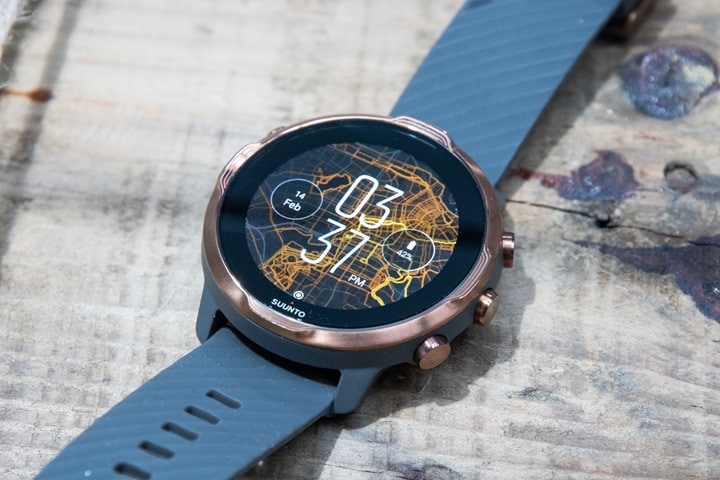
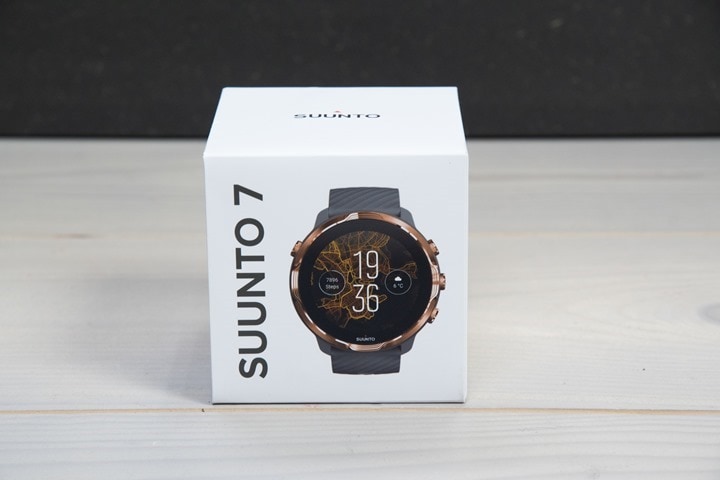
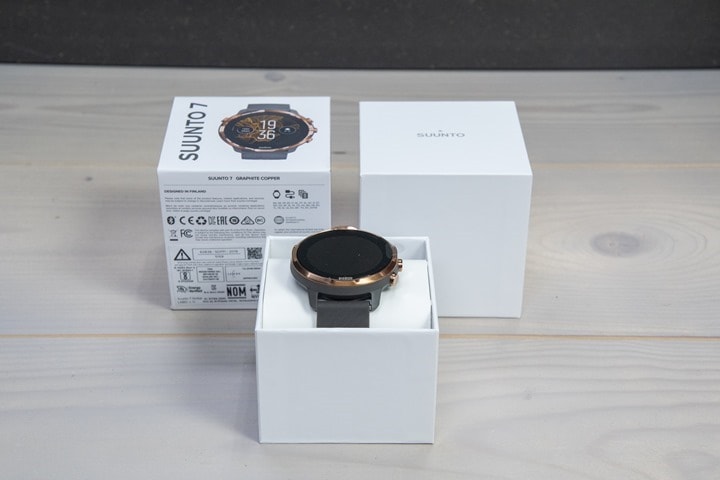
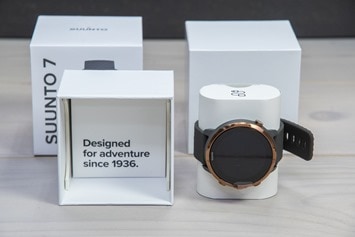
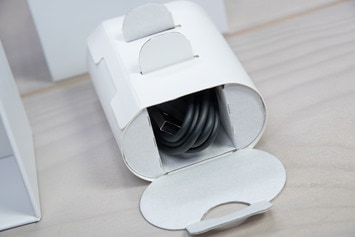
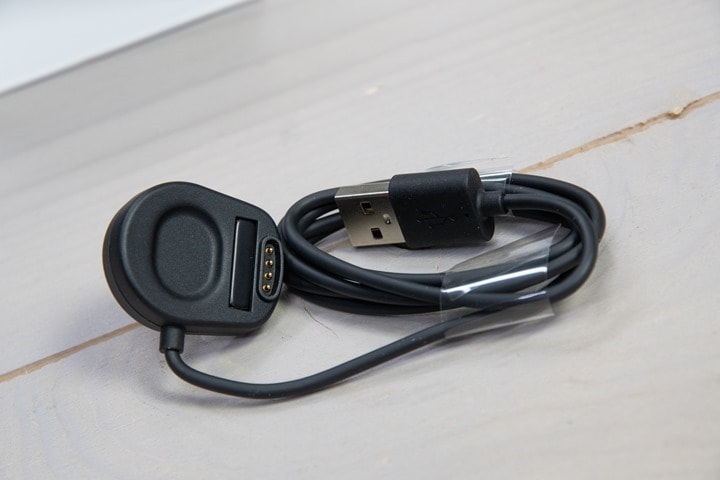
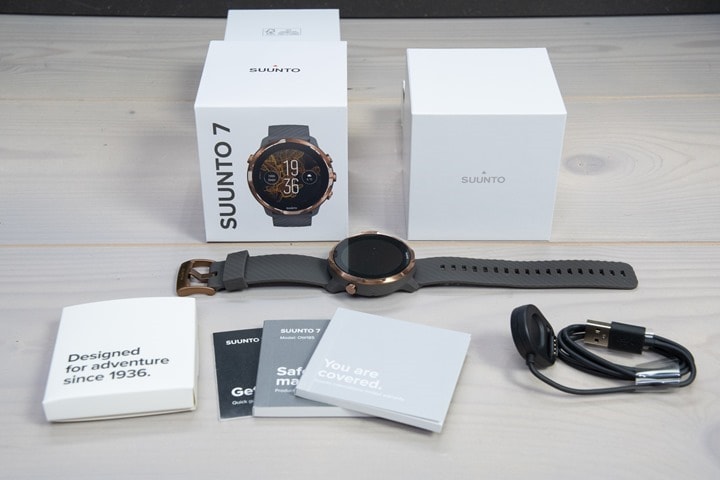
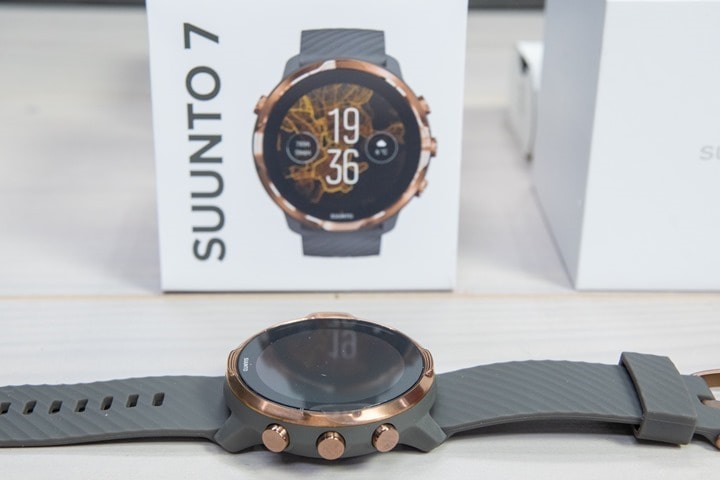
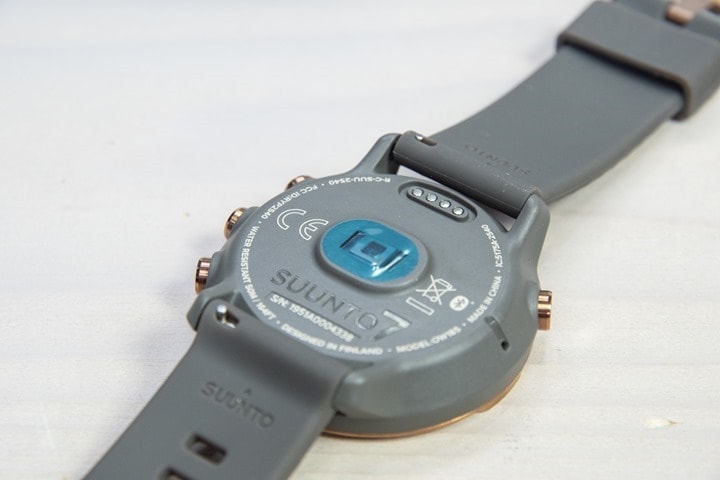
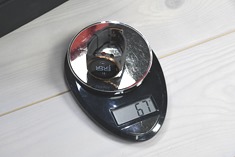
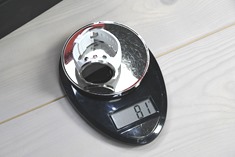
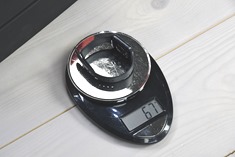
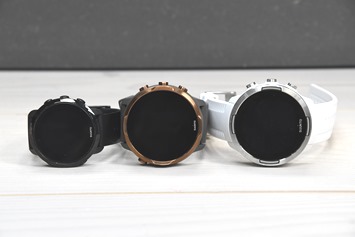
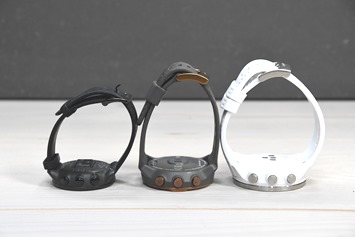
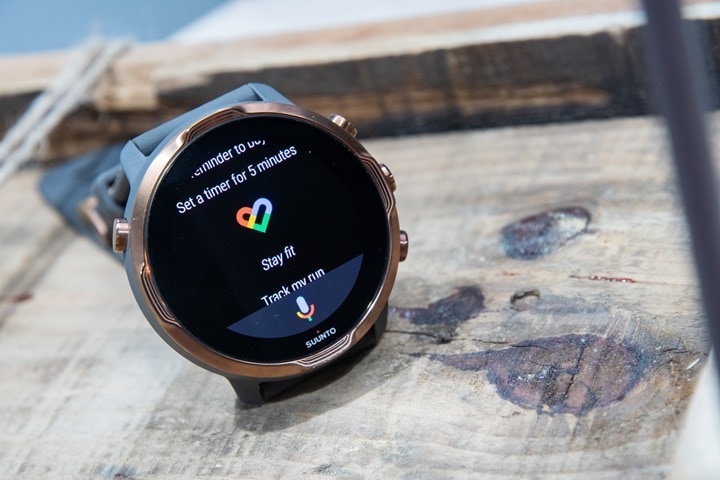
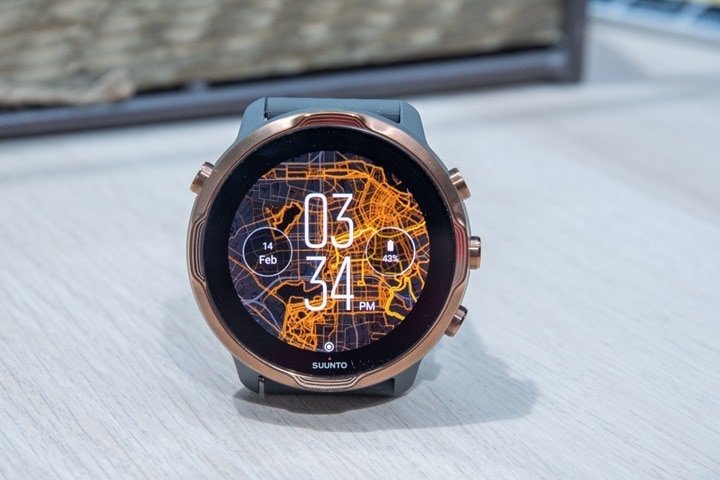
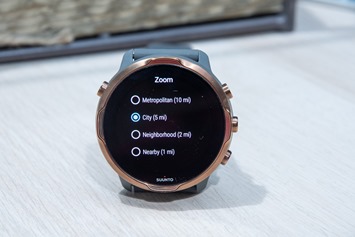
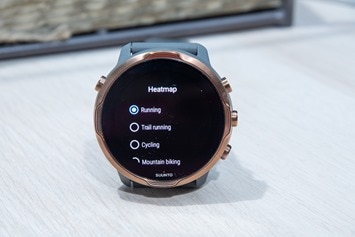
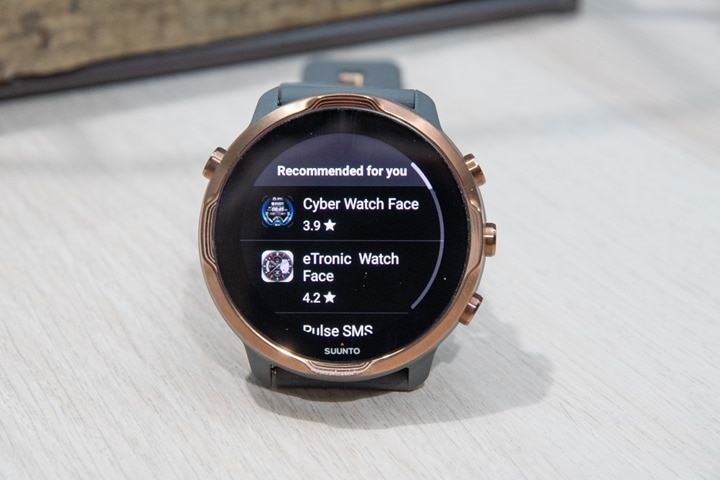
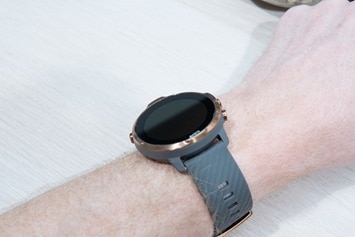
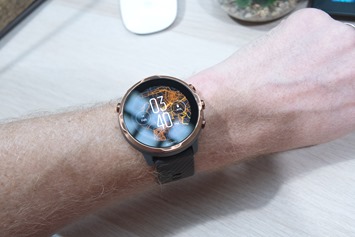

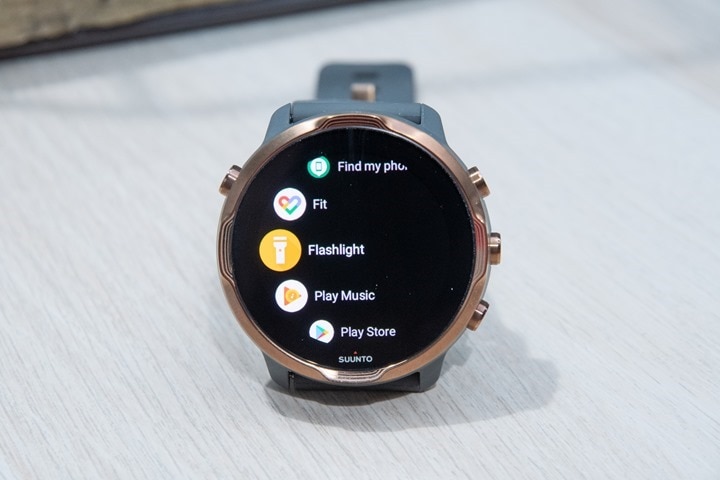
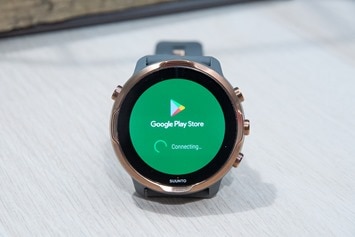
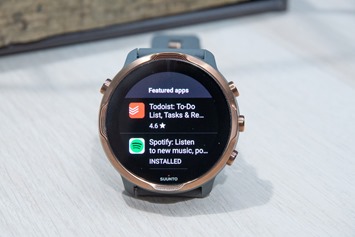

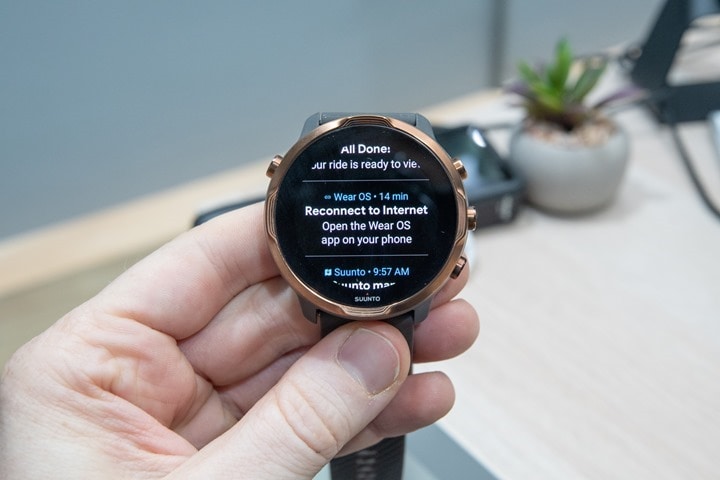
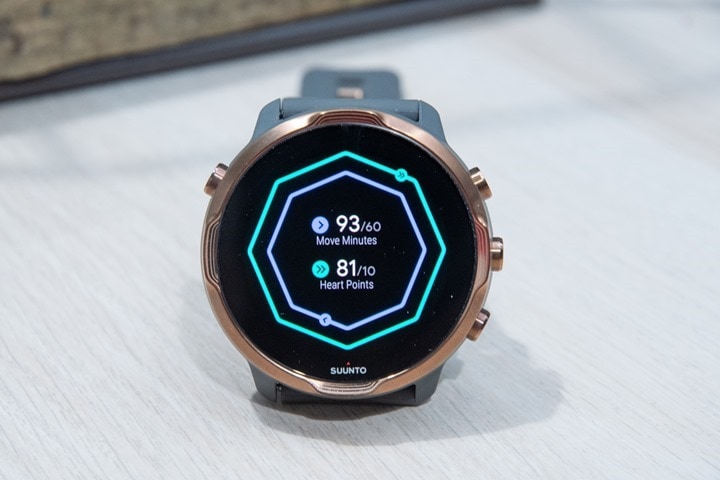
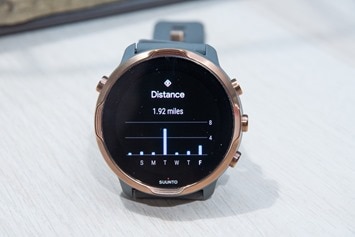
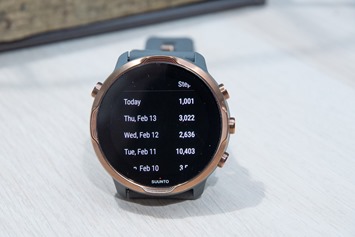
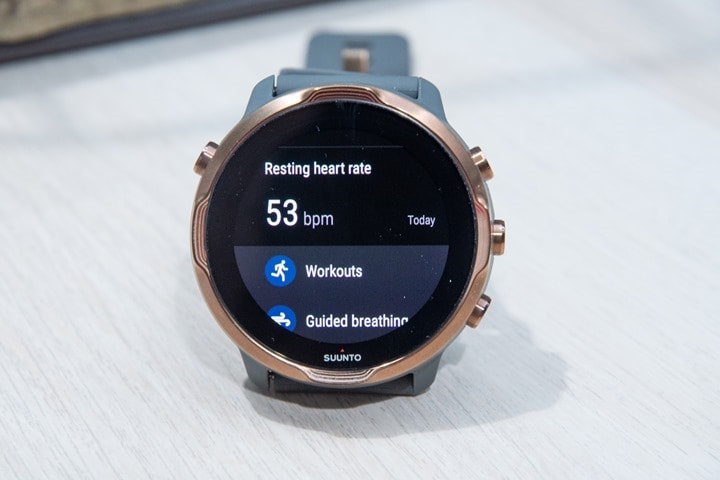
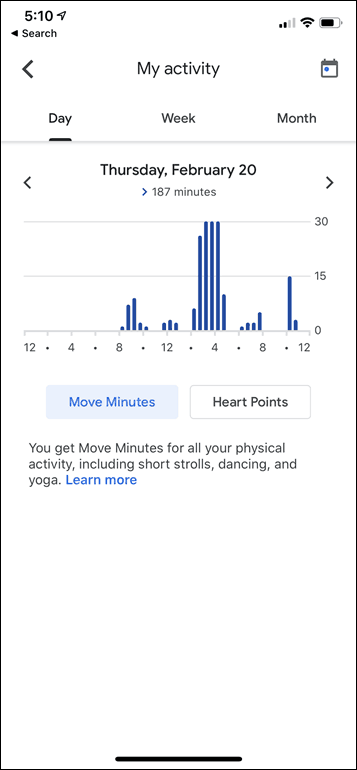
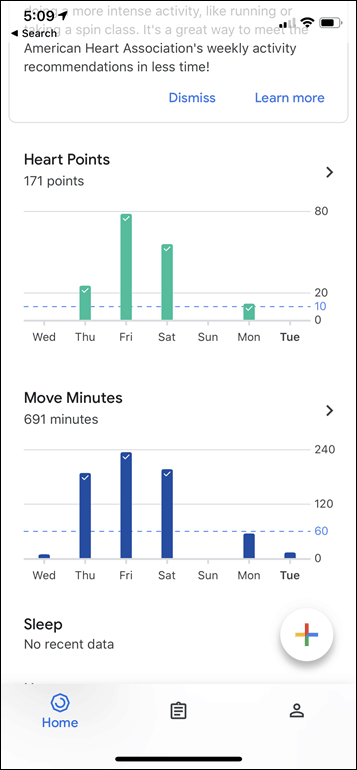
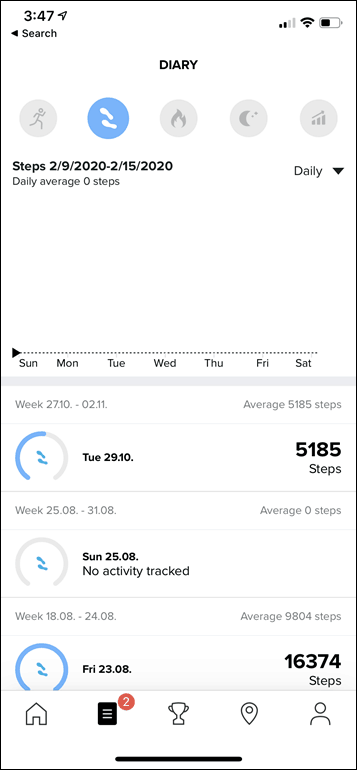
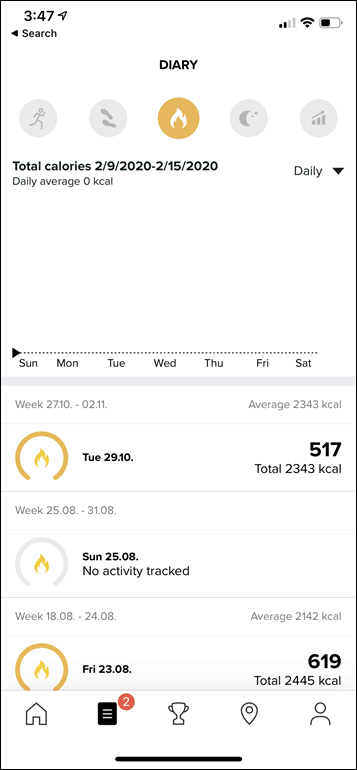

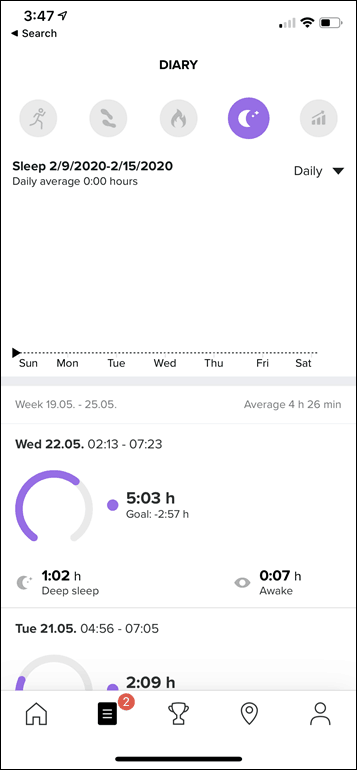
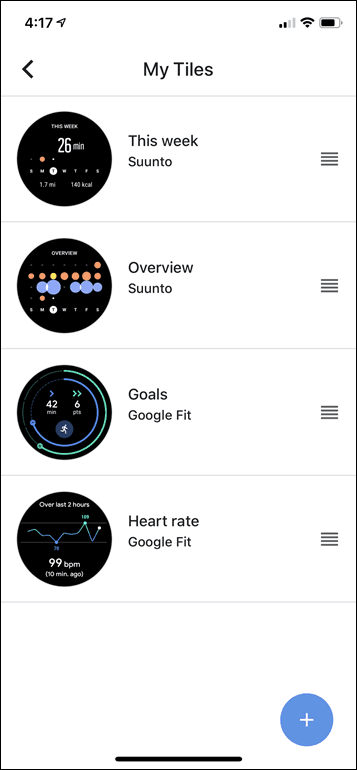
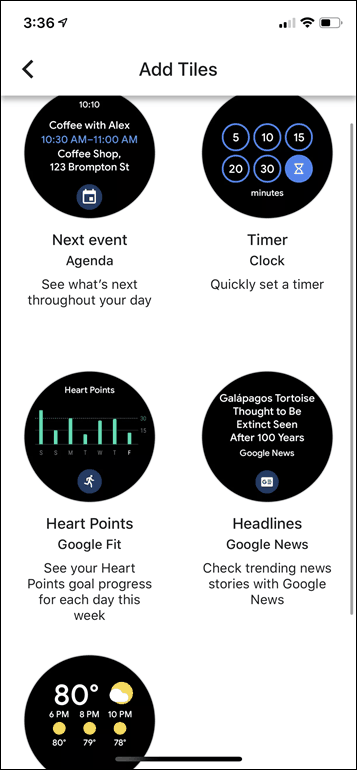
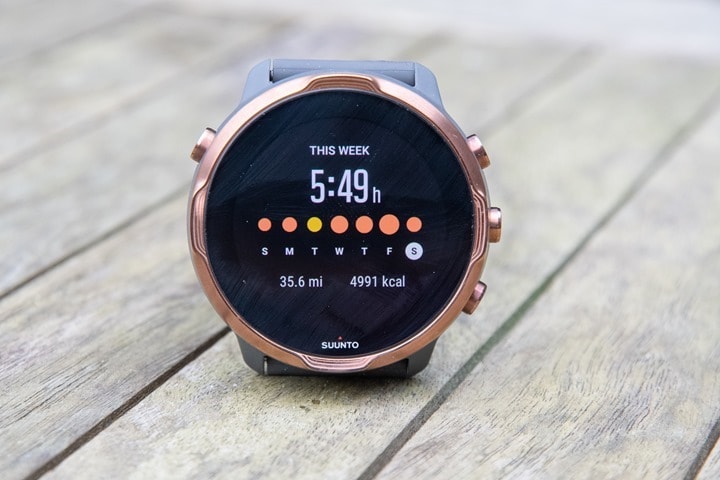
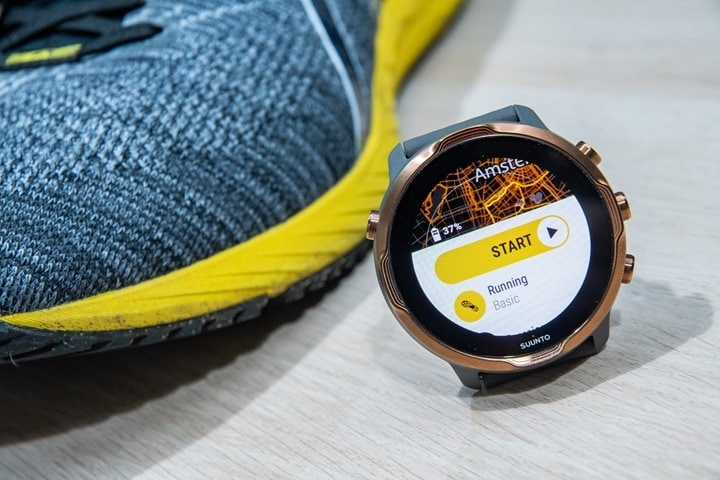
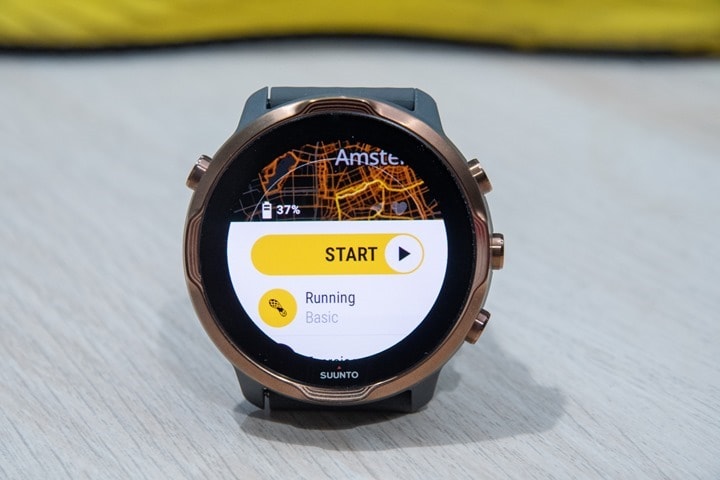
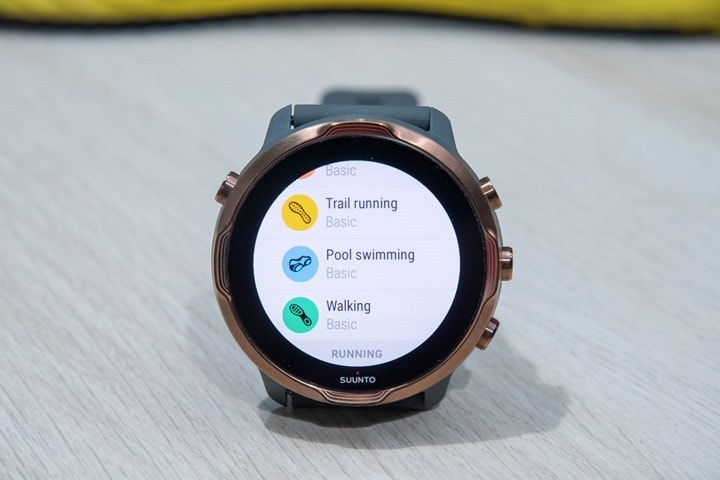
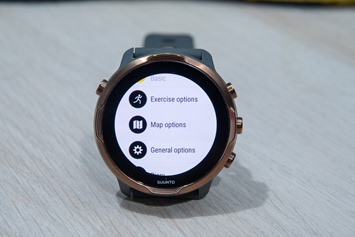
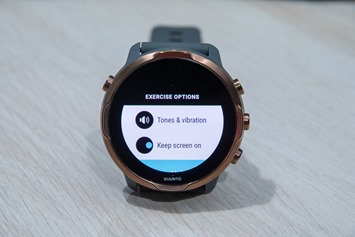
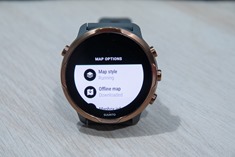
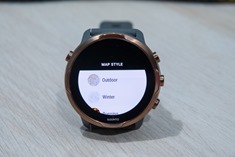
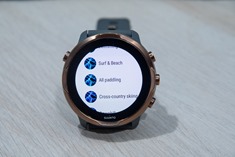
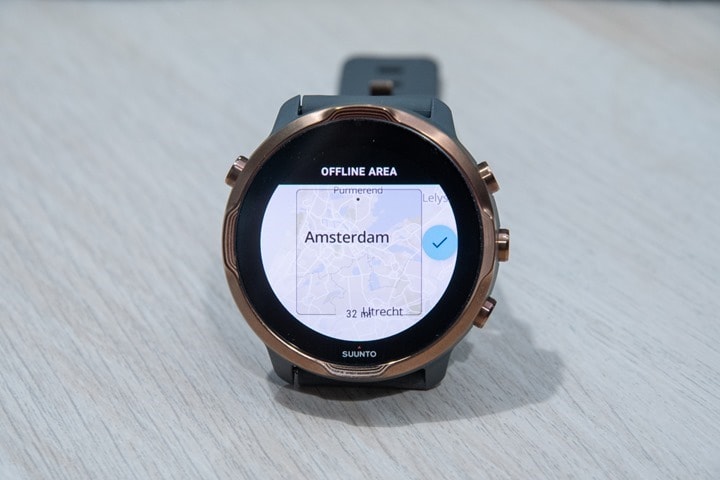
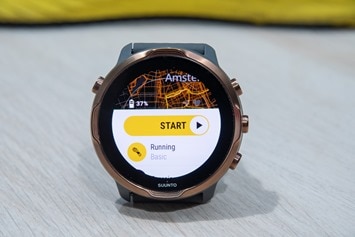
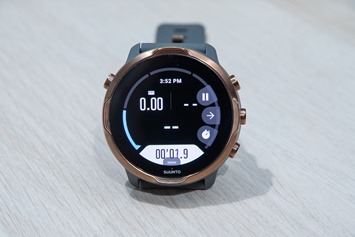
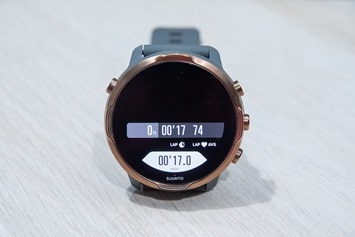
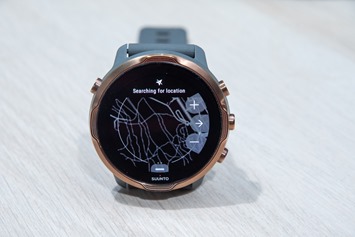
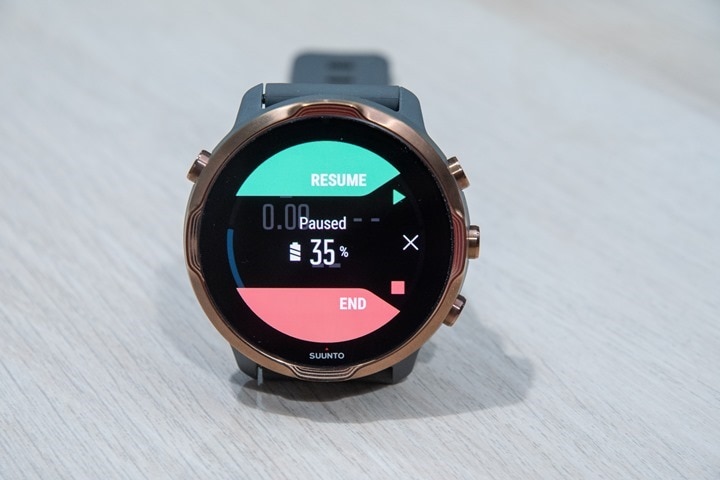
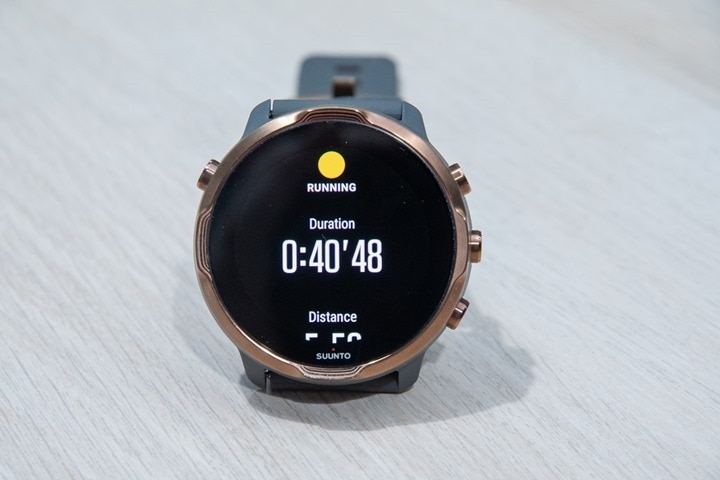
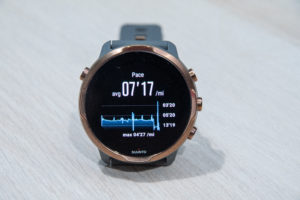
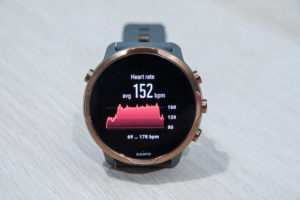
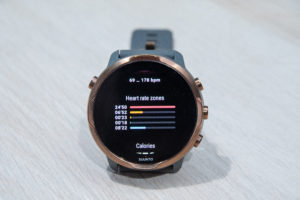
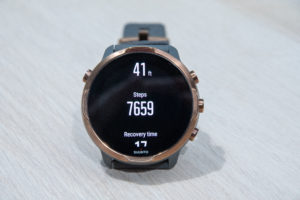
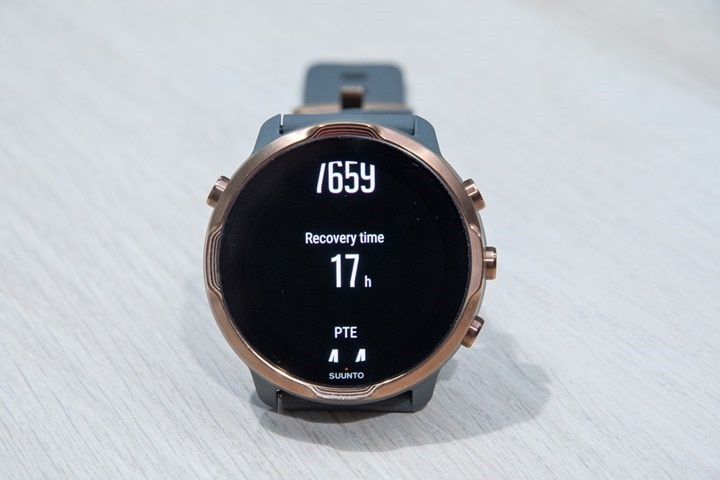
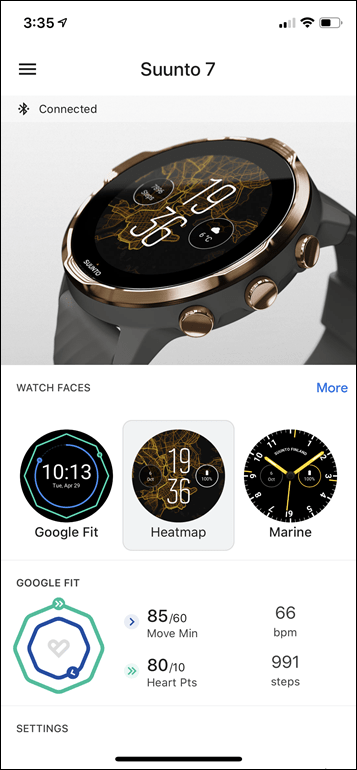
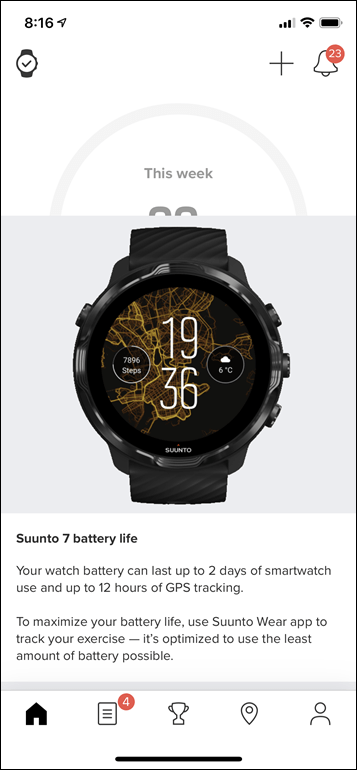
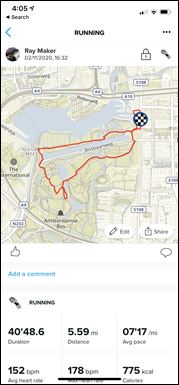
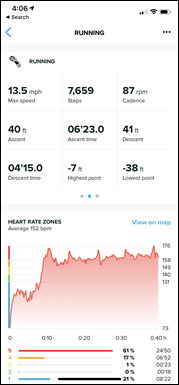

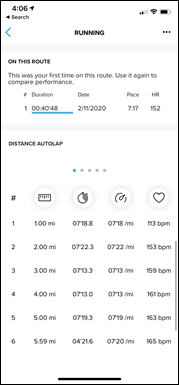
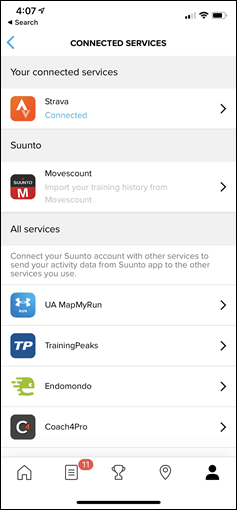
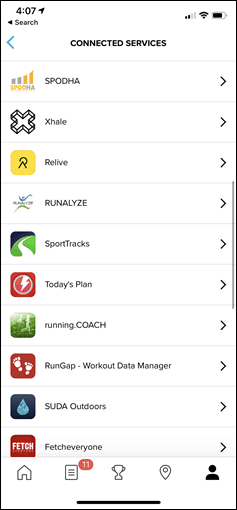
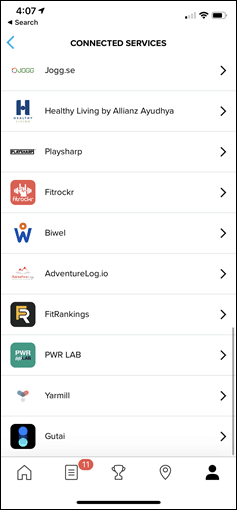
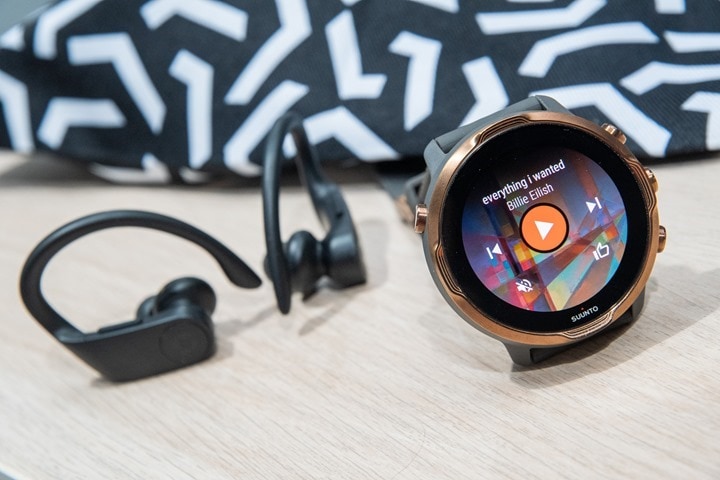
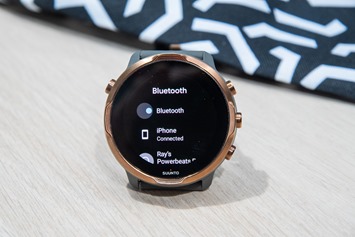
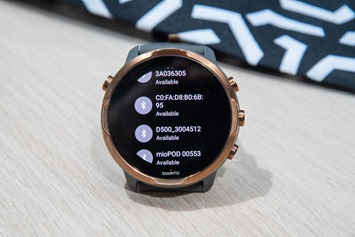
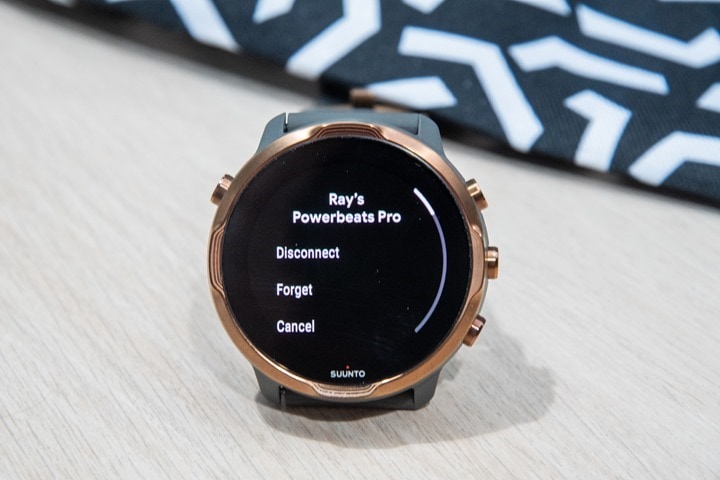
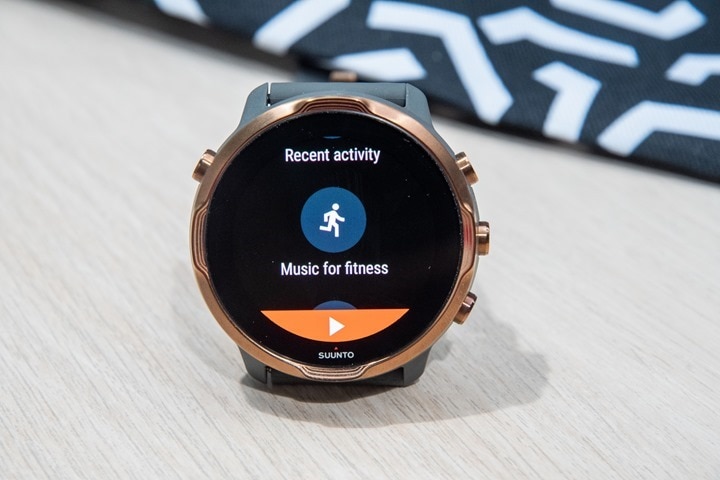
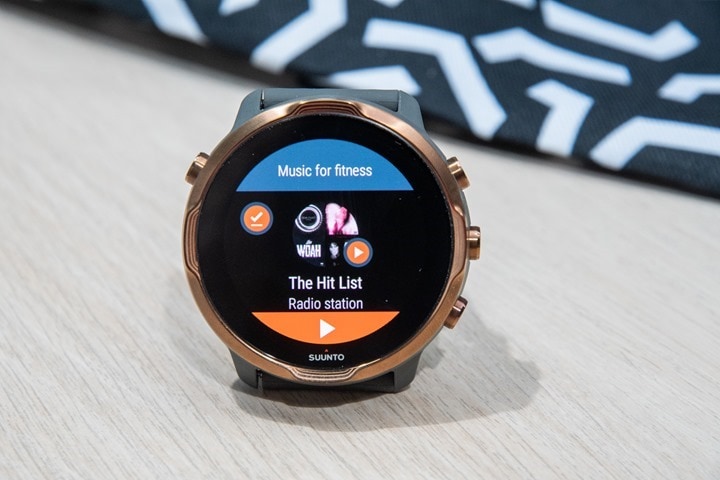
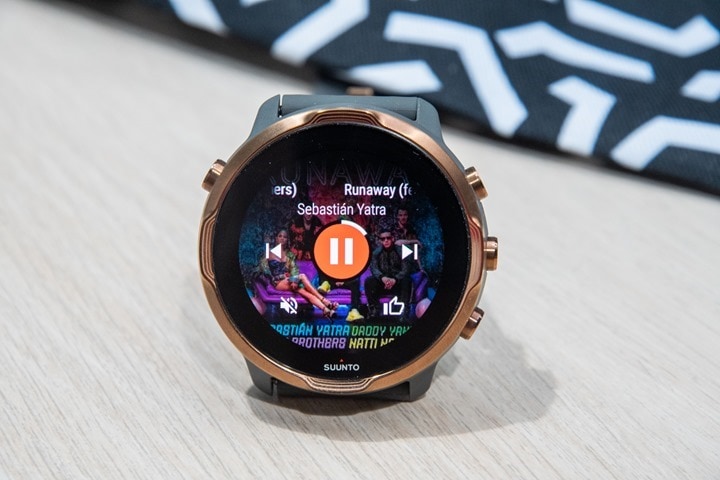

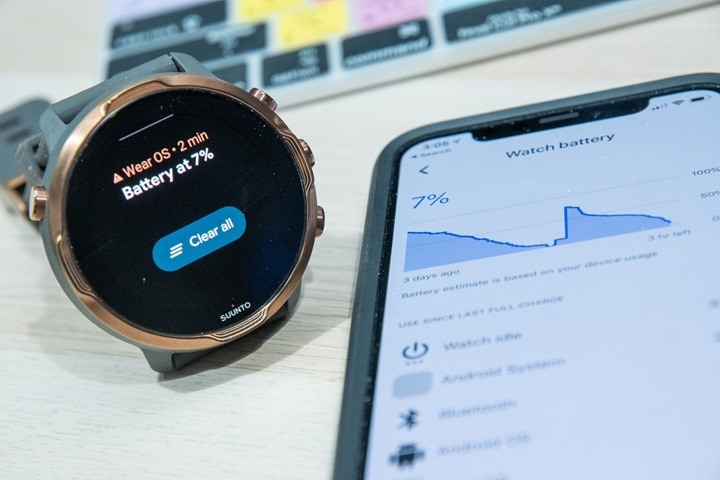
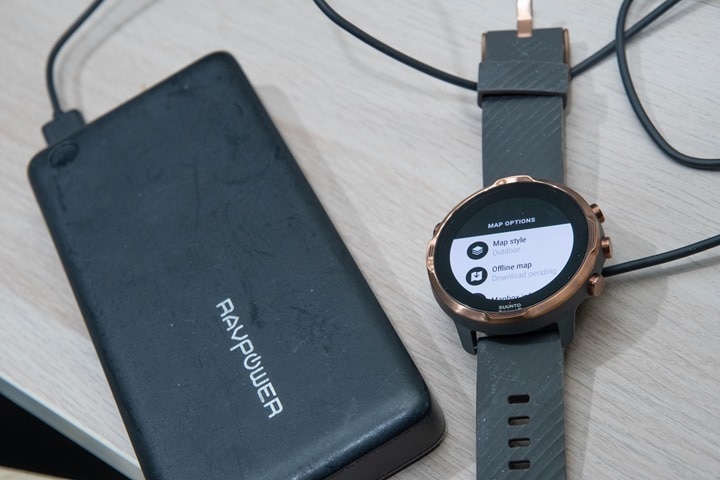

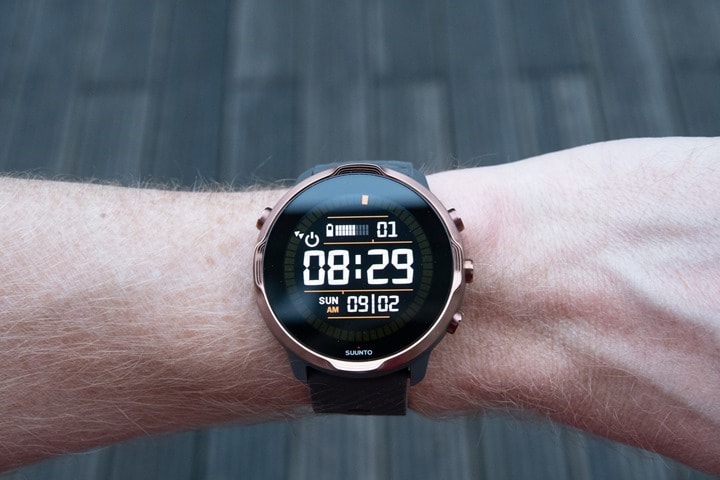
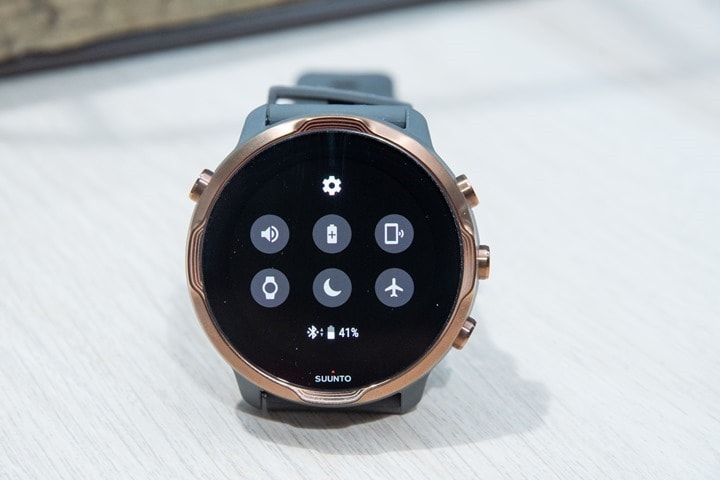
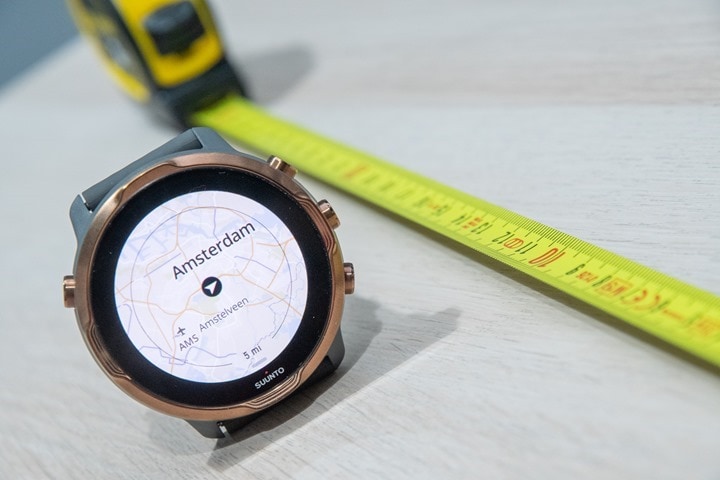













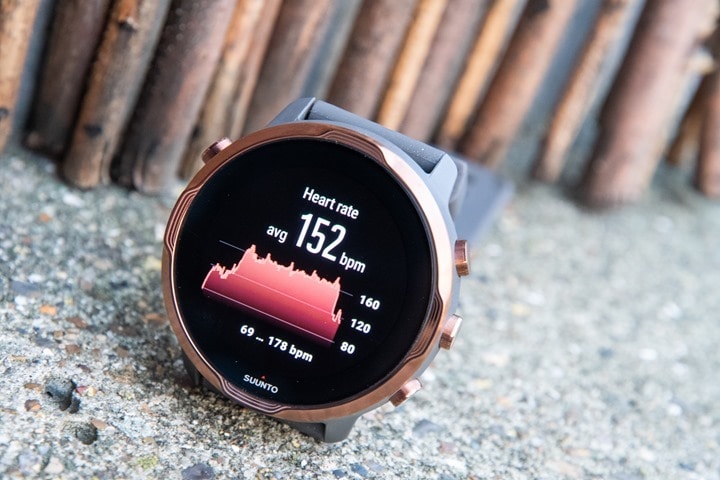
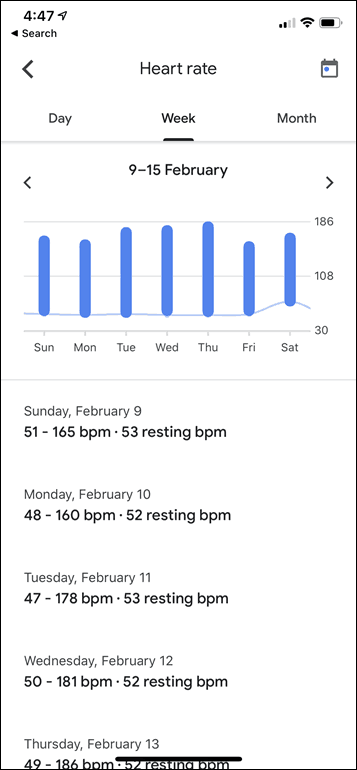
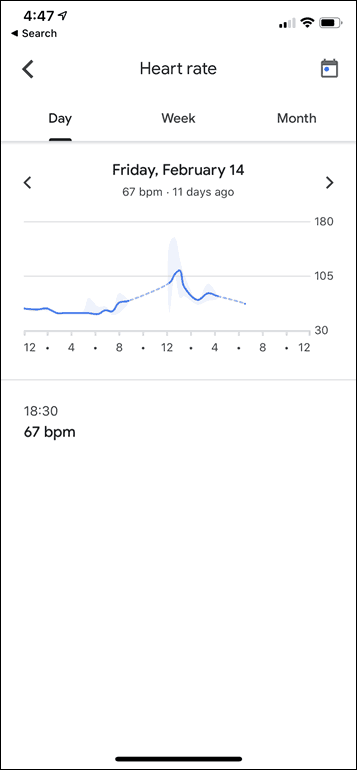













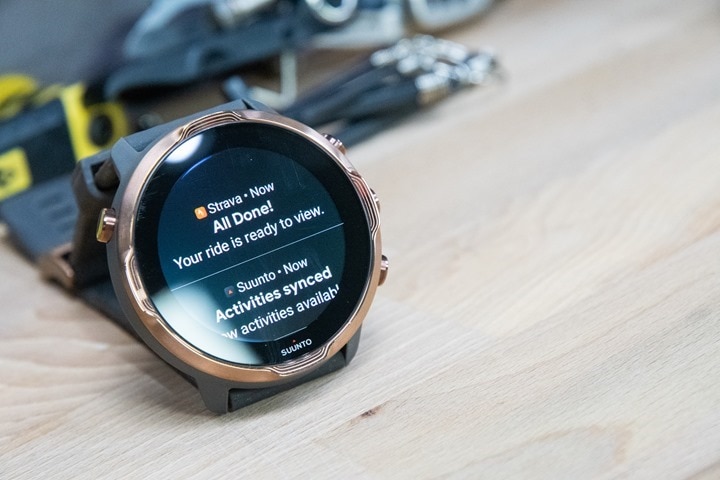
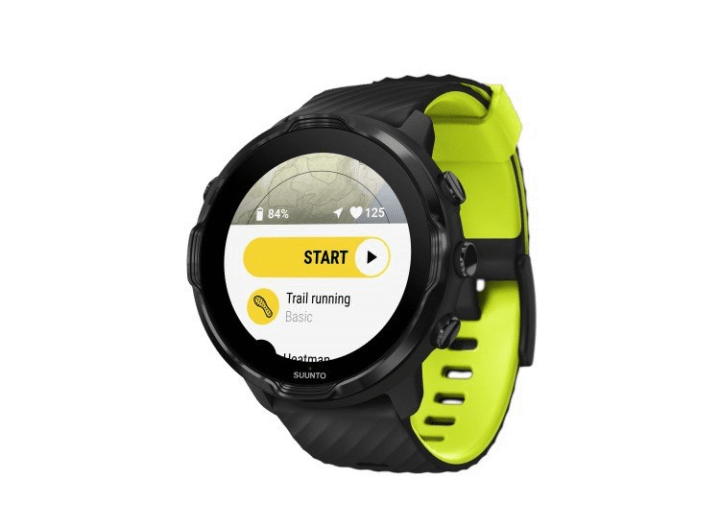





















Wow, I was hoping that Suunto would be a reliable replacement for my buggy & low-battery Garmin FR935. What is your best advice for a watch to endure a full IM in September? Is the Wahoo Multisport watch still to expect this summer?
In general I think the best strategy for training for a September IM is to train on the watch you know starting this spring. Thus, I’d shop what’s already in the market.
I would just use the 935.
935 battery failed me during an Ironman a couple of years ago (~12 hr finish time). Traded up to the 945 and that had no issues lasting the duration last year.
A bit cruel and garmin fanboy right?
You lost me for sure.
Back in the new days that DCR would not hammer any company and judge a product by it’s target audience not against his favorite one.
That’s actually why you will never expand….
Sorry, I found this in the spam folder from Feb 25th). No worries, I just fished it out just for you.
See – here’s the thing – the Instastory post was funny (and I make equally funny ones about Garmin products too – except nobody gets all bent out of shape on those). But best of all: It’s actually 100% accurate. The battery doesn’t last long, and no amount of anyone’s hand-waving changes that. That’s a very factual thing. It burns battery like nobody’s business. If you don’t like jokes or factual statements about the downsides of products, then you’re welcome to read various other sites.
As for the ‘target audience’, I keep seeing Suunto S7 defenders say that, yet that doesn’t match Suunto’s own marketing. After all, Suunto specifies this is a GPS sport watch. But sure, as I’ve highlighted numerous times in the post, it seems that the most ardent of S7 defenders like to somehow ignore the $199 Apple Watch S3 (which has better battery life, far better app support, and better GPS & HR accuracy). Sure, it’s not on Android phone – but that’s fine. The $199-$299 Samsung Galaxy Watch Active series watches are. Which again, are actually more functional for Suunto’s demographic. I judge products cheap and expensive by their target demographics, which in this case was squarely by Suunto’s label on their own home page (go read it, I’ll wait).
Finally, as for expanding, every metric I have says otherwise.
It is funny to dig through old reviews from time to time. Fast forward almost 4 years and the gains made in the sports fitness watch scene is pretty pretty pretty good! Suunto has made really nice gains with the Vertical and Race for sure. Garmin continues to lead the way and to think we have an amoled watch that lasts allmost a month without charging (Epix Gen2 Pro 51MM). To say consumers are spoiled is an understatement.
Thx for the review
So pretty typical of Suunto’s last few releases. In two years when they’ve ironed out the issues that shouldn’t be issues and release a new hw revision to hit a sane price point is this a viable direction for them?
I think long-term it’s a viable solution actually, and honestly, they’re only option. They already can’t compete with Garmin feature-wise, and going to the same GPS chipset means they lost out on any accuracy gains they used to have. They know this too, and will readily admit they can’t compete with Garmin on features.
I think the Wear OS direction makes a ton of sense if they can find a way to pull in basically the entire Suunto 5 watch into the Suunto Wear OS App. Which, technically should be totally viable.
The problem is that Suunto just doesn’t apply enough resources to developers. It’s always been an issue. I get the feeling that the software development staff for this watch numbers maybe barely double-digits, if that. That’s but a fraction of what they need to be competitive in this market.
Same goes for the platform side of things too.
If you were in the market right now, what advanced running watch would you go for? S9, Vantage, 945, Coros? I run trails and roads, mainly roads recently with lots of distance. Thanks!
Coros Apex 46mm as long as you don’t take their garmin-like tss etc metrics seriously.
So, serious question: why are any of these companies still bothering to try and compete with Garmin in the full-featured high-end multisport watch space? What was the last non-Garmin watch in that market that was competitive with the Garmin 945/Fenix 6? Polar? No. Suunto? No. Coros? No. Not a Garmin fan boy, and I don’t think you are either. But, seriously? Wouldn’t they all be better off focusing on the lower-mid priced market and trying to undercut Garmin at that level.
@David E.
Honestly, the only watches that I see out there that make any worthwhile sense are the Coros Pace at $200, Coros Apex at $350, and the Polar Vantage M at $280.
I mean, I only have the Forerunner 245M, but I can make full custom workouts and carry music with me without a phone. No other manufacturer offers this without resorting to Google Wear or some other type of smart OS that has shitty battery.
Coros Fanboys love to talk up their watches, but let’s be honest — battery life isn’t everything. Charging every 4-5 days isn’t a big deal (versus 7-8 days), and not many of us care about >24 hour battery life. The Apex Pro is overpriced the minor upgrade it is, and the Vertix is in stupid overpriced category that only has extreme battery as a selling feature.
It depends on what you deem full featured maybe? I’m a long time Polar user who swore my next watch would not be a Polar device. However, when I started to research, I crossed off NFC and Music. To me, they are lifestyle items, a ‘nice’ addition (full featured?) but I wanted a dedicated training watch. I was fully headed for Garmin and then a friend told me about the two Fenix 5’s he returned due to issues. And then another friend had a similar story about how his barometer failed and Garmin gave him a refurb. Then I read multiple forum threads about cracking issues around certain Fenix HR sensors. So I looked at Polar again. I shopped around and was able to snag a Vantage V for $400 CDN all in, out of the UK. (That’s like $320 USD?) Almost the same price for the Vantage M. There are things that I wish Polar would add like a drill setting for swimming and ‘maybe’ Ant+ (cuz’ the watch has the hardware, C’mon Polar!) but all my sensors have BT so no big deal. But battery life is great, I have running power at the wrist and GPS is much better since recent updates. Just my opinion , but in looking at their past products I’m not convinced Polar was ever trying to compete with with Garmin in the full-featured high-end multisport watch space (maybe the M600?). A Vantage V, even at regular price it’s still a lot less than any of the Fenix 6 or a 945 that I saw while shopping around but as you say, without NFC or Music, it’s not really full featured maybe? So are they really trying to compete or just focusing on a niche?
@Jay, Polar Vantage V vs Fenix 6 or 945 isn’t a fair comparison. Garmin are already several models ahead of what Polar is offering. It would be more fair to compare the price of a used Vantage V to a used 5x or 5 plus (or maybe even a fenix 3hr!!!). There you’ll find it more even. Heck, I bought a used 5xPlus one week after the F6 was announced for $398 last year. Good timing, but now I have a watch with NFC, Music, and a feature you left off, but is really, REALLY important, routable maps with turn-by-turn directions. You can buy a used Garmin VivoActive 3, and after downloading a multisport app like HMSport, you’d probably have more functionality than the Polar Vantage V (which has no apps to add functions).
I am no Garmin fanboy. I have wanted to go in a different direction for a long time, and I keep waiting for a WearOS watch to come along and sweep me off my feet. But at this point, there seems to realistically be no reason to buy anything other than a Garmin. There is something in their lineup that is more functional AND cheaper then then a similar offering from any competitor’s lineup.
People often seem to say you can’t beat Garmin on features, but at this point I am not really sure where you can beat them??? They are ahead in features, ahead on GPS accuracy, ahead on HR accuracy (at the wrist), ahead on maps, ahead on battery, ahead on routing (heat/popularity routing), ahead on agreements with banks for payments, ahead on music partners/apps, ahead on customization/data pages, ahead on app ecosystem (barring apple watch and WearOS, but even then the gap is smaller than you think), and even the biggest complaint, lack of reliability/bugginess, is something that besets EVERY single one of their competitors too, and is offset anyway by having good customer service and willingness to quickly repair/replace problem units.
Even a company trying to compete in a niche area like Whoop seems massively overpriced ($30/month), and I am not sure the data they provide is actually more useful than any of the Firstbeat stuff Garmin gives you anyway, and with none of the other myriad features Garmin offers…This is also assuming the data going in is being recorded well too, which Ray’s examples in this article calls into question.
Good points all around and can’t disagree. But perhaps what I see as ‘full featured’ is different from what others see as full featured. And also perhaps it’s just that I’ve never really thought of them, Polar, in the fully featured market; i.e music, nfc, apps. And I suspect they never will have those. The Vantage V does have route navigation (does that count as routable maps?). And if I wanted Music and NFC I think Apple watch as a daily wearable. But that’s just me. I never listen to music while riding or running and my phone has NFC for POS purchases and stuff. Yes, Garmin is way ahead in these and other features so perhaps they are in a league of their own (premium?). But when looking at how I train and what I need my watch for It’s just not ‘more’ features that I want or need. From what I can see, Garmin is trying to be too many things to too many people. Ray’s article from last June (Garmin’s Biggest Competitor Is Their Own Software Instability) was an eye opener in many regards. As were the 790 comments that followed. Before that I was all in. Music, NFC, the works. It didn’t cement my choice but it really caused me to refocus on not just what I wanted, but what I needed. From a training perspective only, a device like the Vantage V, to me, is fully featured. But from a ‘lifestyle’ perspective, where one might want music, nfc, apps, etc., I agree, it does not compare or compete. But again, I don’t think that Polar’s thing and I’m not sure Polar meant for it to be..
I see a lot of trail runners still using the ambit peak 3 during trail running because of superior accuracy in comparison with modern Garmins/other watches and reasonable accuracy during ultra trails with lower accuracy settings. With the introduction of the spartan series and the Suunto 9 I have the feeling that a lot of these rather loyal Suunto users have switched their allegiance to the Fenix 5x/5+/6pro series because of loss of function, less reliability and less accuracy.
If Suunto would make a watch with the accuracy of the Ambit peak 3, Battery life during activities with areasonable accuracy of 48-60 hours, the capability of osm based or breadcrumb trail navigation and ditch the optical heart rate meter, activity tracking, sleep tracking and other ‘lifestyle features’, I think a lot of those ultra runners/trail runners would switch back to Suunto again.
You nailed it.
I own a Suunto 9 and while it is a good product and I especially love the battery compared to the Ambit series, I miss my Ambit 2 a lot. It was reliable, accurate and reliable!
On the other hand, It’s been a rocky road with the S9
I bought an Ambit 2 in 2013. It was one of the best things I ever bought. What a brilliant watch. Since then, I’ve had a Spartan Sport (which I came to appreciate) and – now that Suunto decommissioned Movescount – a Fenix 6pro.
It was a tough decision to switch to Garmin, but with every bit of news or product release coming from Suunto, I’m glad I did. What is Suunto doing? Their products are a mess. I really can’t see Suunto being around in 10 or 15 years.
And for all the crap Garmin gets about bugginess or hardware, my Fenix 6pro has been utterly brilliant. I’d never need more from a watch. Incredible piece of hardware. No way is there a better sports watch out there than the Fenix 6. Can’t be.
(incidentally, that Ambit 2 is still going strong. I sold it to a friend, who wears it all the time for his workouts. Suunto simply doesn’t make them like that any more)
Decomissioning movescount was pretty s****.
Suunto app is so far behind movescount.
Should have continued enhancing ambit series.
Got mine delivered Jan 31 (tired of my Fenix 5 & Garmin), a beautiful watch! Battery life not bad, getting 30-40 hours between charges. Very snappy performance, love combination of hardware buttons & touch screen. Altimeter, GPS & HR acceptably accurate.
HOWEVER, has MANY shortcomings! NO external sensor support except through 3rd party apps. Eliminates useage of built-in sports & convenient launching with top button!
HR can only be read as frequently as every 15 seconds at best during activity tracking and for watch face display!!! What a joke.
NO built-in sleep tracking! 3rd party apps all expensive and difficult to setup & use.
For a brand-new released 2020 watch at this price, it’s very disappointing. Bought a Garmin Venu at the same time, and while the hardware from Garmin PALES next to the Suunto, Garmin software & functionality is FAR SUPERIOR! And still, FAR from perfect.
Going to have to compromise either way, but Garmin has much needed, critical functionality! Really wanted to like the Suunto 7, but TOO MANY shortcomings, sadly. Back it went last week, ordered & received 6x, and while it clearly lacks the craftsmanship of the S7, at least it works! Rather put up with all the Garmin shortcomings, and have a truly functional watch.
On top of it all us we can’t actually reach Suunto support (USA phone number does not work from Hawaii, and can’t find chat they advertise).
Gave the Venu to my wife to replace her Galaxy Frontier, she loves it.
Here’s hoping Garmin uses AMOLED screens on the next Fenix, & keeps improving fitness tracking, HR & GPS!!!
I’m using it since a while, and for me the OHR is the best I’ve had ever… maybe you have a faulty unit?
Can you do a comparison with a chest strap? Or perhaps another watch?
“It’s simply half-baked.”
All is said and that seems to be the trend of Suunto in those last years.
This is sad
Wow it’s bad.
The fact the optical sensor is that bad and you didn’t even get to mention it in the Wrap-up shows how bad this watch is.
Have three weeks of workouts on S7, many measured against H10. This is by far the best OHR sensor in Suunto watches and on par with Polar and Garmin. Anyone who doubts that can hit Suunto 7 forums. There are plenty of posts comparing S7 to other watches/sensors
I’ve yet to see anyone with ‘good data’ actually produce true side by side comparison charts with the Suunto 7, except for the 5KRunner. And in his data, it was so-so to good indoors, but pretty bad outdoors.
I’d love to see some more charts of folks side by side. Not just comparing a total ‘average BPM’ at the end.
Actually, ask and ye shall receive. Gerald Zhang-Schmidt, a Suunto 7 tester (and maybe Suunto Ambassador, not sure these days), posted his HR/GPS/Battery accuracy charts just an hour or two ago.
As you can see, it basically matches what I see: HR is bad, GPS is fine, battery burn near identical to what I’m seeing: link to uhrenundtouren.com
Hi Ray & co
yes indoor treadmill showed good oHR, turbo could have been better ohr and upper body weights ohr not good (but the latter is normal ohr behaviour for me)
outdoor bike ohr was surprisingly bearable but even outdoor easy runs were not as good as i would hope for.
gps was similar to recent garmins but jaggedy in places
Here is a ‘day in the life of the battery’ with exercise
– 8 am. wake up and turn on the already fully-charged Suunto 7
– 9 am to 1 pm ride with GPS enabled, stopping indoors for a coffee (poor GPS, increased battery searching for it?) for 30 minutes
– 1 pm to 2 pm outdoor run, no music
– At this point, the watch read just under ** 50% **. I think it was 48% or 46% (10%/hour burn)
– Normal ‘watch’ mode for rest of day took the charge down to 21% by 11 pm.
– 9 am: wake up and the battery saver watch face was showing
Excuse the self-promotion (it’s a series of Suunto 7 ohr/gps/elevation charts): link to the5krunner.com – this also has some links to blogger Eduardo in Spain and his data. His oHR results are better than mine (temperature?)
Funny, you’re day in the life of battery life stats are actually very close to mine in terms of skiing. Slightly different make-up, but essentially ending the night around 11PM to 12AM in the teens.
As I chatted with The5k, I’m having good results with the oHR from the Suunto 7. And they are much better than those you two have showed. They are not stellar, but at least generally good.
Steady runs are almost spot on (some minor quirks and usual late lock). Very short intervals were “kind of”, but the export bug from Suunto didn’t help. Track workout was very good. Cycling is hideous, but that’s to be expected.
Temperature could be one reason for sure. My “cold” workouts have been as low as 14ºC, so that could make a difference. Others have been at 20ºC or even 23ºC. I know you guys are training at a much lower temperature, so definitely something to check.
Regarding battery life, I have always made the full day without taking too much care. GPS use has been variable, but with some rides in the 3-4hr ballpark, and I always finish the day with 20 to 40 percent left. I just charge it at night, just like I did with the AW5, and I think this is how they are intended to use rather than trying to squeeze it to two full days.
I’m rounding up my review. I like the watch, but I think Suunto has come short on their side… again. They have a “developing power” issue and I can’t understand why they can’t see it when everyone does.
If I had to define the Suunto 7 with just one word it would be “frustration”. Their left hand doesn’t know what the right hand is doing.
Agreed. My 7 is great for low HR stuff like hiking where it’s on par with my Garmin’s. But hit a faster workout and it can bet patchy. Sometimes it’s lineball with my FR245 to th ebeat for an entire workout, and other times it’s all over the place. That is the only frustrating part of the watch really. I couldn’t buy an AW that only lasts 18hrs between charges. Ridiculous. I only charge my 7 every second day so for me that’s fine. And that;’s with noti’s and alarms etc turned on.
I really hope Suunto can make the watch last weeks as Garmin have with the new Epix. It’d be a game changer then for Suunto. Live in hope….
Man! I really hate piling on here, but who on God’s green Earth would buy this set of features at this price?
An Android user, non-endurance athlete, trying to pose as an endurance athlete perhaps? And with no concept of money, and no time to shop/compare devices? Maybe that happens to be strolling by the Suunto stand in that Western Shanghai mall?
“An Android user, non-endurance athlete, trying to pose as an endurance athlete perhaps?”
Yes, perhaps – at the right price. To some degree I think that’s what Suunto was going after here, but they failed (hugely) on price. Even Android Authority noted this (heavily) in their review that the price was basically a non-starter.
I think Suunto is basically trying to replicate the success of the Instinct here, which in turn totally copies what Casio did. The Instinct has been a mind-boggling success for Garmin (something I wouldn’t have guessed pre-announcement). But the Instinct is essentially a mini-Fenix, that looks like a Casio. Whereas the Suunto 7 isn’t a mini Suunto 9, 5, or 3. It’s…well, it just looks like a Suunto.
If Suunto had priced this at $249-$299, they’d be in a different position. Yes, I’d still have given them a hard time for the poor optical HR, the lack of basics (primarily step stuff), and other aspects that competitors have. But at least it would have been ball-park appropriate on price.
Couldn’t agree more on Instinct. Who saw that coming?
Best explanation is the G shock style has become somewhat of an anti AW statement. More masculine/sporty. Tell yourself you’re a SEAL. Not my personal style but Garmin marketing seems successful with this “tactical” angle.
And meanwhile Venu launch seems so so at best! Product marketed with a weak looking office drone and woman swimming in purple liquid.
Don Draper: “what you call love, was invented by guys like me, to sell nylons.”
Until Qualcomm gets their act together for a chipset thats not years old and Wear OS is actually better supported I am mind boggled why Suunto went this route instead of making an inhouse OS. Garmin did great at doing it for their watches. Companies like Tesla does not put Android Auto or Apple Carplay into their cars and build their own OS that does all the features that others do. Just proves Suunto is behind the times and doesnt take software serious.
Seriously, read my comments below, battery life is excellent! I think this is the Suunto app doing this as I don’t use it and get amazing (for Wear) performance. I also don’t get the disconnects.
Standby life is so-so for a smartwatch, but GPS-on battery life is bad by any metric one uses to any non-Wear OS watch in the market today. I’m not sure why at $499 Suunto should get a pass for poor GPS battery life just because it’s less sucky battery-wise than other Wear OS watches.
You’re looking at it wrong.
You want a total fitness watch with some smarts
This is a smart watch that does fit. That flexibility of the processor and OS allows for a shed load of apps and a bazillion watch faces. That costs in battery.
Ok, so – let’s pretend that’s the case.
Why is it worth $499 – far more than virtually any other Wear OS watch?
And that ignores the fact that other higher-end smartwatches are roughly half the cost ($199 for AW S3, which is equal on specs to this), Samsung floating around $299 or less depending on model. Fitbit at $250 or less, etc…
It’s worth whatever people are prepared to pay for it and, judging by the fact it’s sold out everywhere with weeks delivery on some sites, it seems more popular than Suunto thought and manufactured!
You don’t think a Rolex actually costs $2000 of raw materials and labour, do you?
Yes, it’s overpriced but, doesn’t seem to have hurt demand based on market availability.
I see Suunto 7 stock just fine on both Amazon and Clever Training (at left).
I know they were limited early on, primarily due to planned low production numbers.Going forward, I suspect they will also be impacted manuf-wise by Coronavirus, given the watch is made in China (just as its impacting every other company in the sector).
Suunto thanks you for doing their product testing for them.
Oof! I have a Suunto Wrist Spartan HR (or something like that) and it’s quite good. I have ancient Suunto Vector watch (no GPS or sports orientation), but a brilliant, durable piece of kit that I bought used about 12-15 years ago and it’s perfect – really impressive. How things have fallen for Suunto. It’s clear that the device in this review is a stinker. But here’s the worse part (that Ray does not really say)…Suunto does not get it it. Or maybe they are so desperate that they know what a stinker they are offering, but just hoping that it will all be OK. I’m a Garmin user but not a fan. Suunto seems to be uncompetitive. I really enjoyed early Polar hardware, then fell out of love with their approach of ‘more feature coming soon!’. Coros? Maybe, since my needs are pretty modest. Give me reasonable battery life with useful GPS tracking, a multisport mode – really, so rare, but how hard can this be? – and a sensible upload/web presence and I’m good. Music? I don’t care. Payments? No. Useless ‘advanced metrics’ on running or recovery? Pffftt. It’s not clear why these devices are so expensive and provide so little *real* value. I want an updated FR305 that can read power and not be a brick on my wrist for $199. Done.
“handful” of watchfaces from Google Play?!?! There are literally THOUSANDS if not hundreds of thousands and, if you are inclined, you can design your own from a blank canvas. I do this to match the colour of my strap.
I find sports watches to dumb so having moved Polar m600 to Fenix 5 I’ve now moved to this 7 so, this is my background.
First OHR’s are useless to me so, I’ve always used a Polar strap during excercise. I’ve also not even opened the Suunto app and went straight to Endomondo. Now, I notice that the battery is exactly what I need. With EVERY feature turned on (screen, WiFi, NFC etc, not GPS)and screen on 5 all the time I get through. My work and social day and still have 60% remaining. I wonder if your battery issues are caused by the Suunto app? I also don’t get the disconnects you get, maybe again the app?
In addition, I don’t understand why people sleep with a watch on?! My wife hates it as much as I do (as I’ll scratch her) so, taking the watch off, like I did my Fenix 5, at night is perfectly normal. I guess the only difference is that I’ll put the 7 on charge which is no big deal. Well, apart from that charger is EASY not to align and charge. A few times now I’ve woken up and I’ve got 50% battery but hey, not such a big deal as that gets me through the entire next day!
I’ve got a slightly different take, I guess. AT LAST! A Wear watch that has absolutely NO battery issues and I can go to work, come home, hit the gym, go out for beers and not be infear of embarrassment at my watch battery running out.
““handful” of watchfaces from Google Play?!?! There are literally THOUSANDS if not hundreds of thousands and, if you are inclined, you can design your own from a blank canvas. I do this to match the colour of my strap.”
The handful part of that sentence is referring to the handful of Suunto pre-loaded ones via the Wear OS app, the rest of the sentence talks to the boatloads of them on the Google Play store (directly on the watch)
And was VERY misleading.
I don’t think you get the target audience which is clearly not you, it’s me.
Nothing misleading in my view. Certain amount of attention is required when reading
I can totally understand why someone who doesn’t do sleep tracking with a watch would think it was unappealing. But, as someone who turned into a person who tracks their sleep with a watch over the past few years, I can tell you that I think it’s great. For my training log, I can see how my performance and restful sleep align. It’s interesting to validate what your sleep data tells you against your impression of how you slept. And like step tracking, it’s an excellent motivator to get more sleep and lead a more healthy life. I also love using my watch as an alarm clock. I have never scratched my partner with my watch, but every time my alarm goes off it wakes me pleasantly and silently, and it NEVER wakes up anyone else. I also don’t like the pressure of having a visible clock on my bedside table. I put my watch in a mode where it only lights up if I make it happen. It’s useful to glance at the time when you need it, and more peaceful to completely ignore it otherwise.
Lol Stuza. You must be head of the Suunto PR department. ;-)
Screen that’s always off is a deal breaker for me, it’s terrible, especially for training but also in watch mode. Also the battery life, omg. Tbh, I prefer my Garmin as a smart watch too over my Samsung watch (gave it away) due to its superior battery life and always on display. It’ll be unfortunate if sports watch oriented companies switch to the wear os oath, but unfortunately it might be inevitable as the smaller companies don’t have the resources to get their OS to the wear os level in terms of features
Man. Too expensive. Really poor OHR. Poor battery life. Why don’t they use one of their transflective screens? That could have improved the battery life. Why didn’t they use the OHR they used on the 5 or 7? Suunto really apparently goofed on this one.
Do you have any experience of your own with S7 or are you just relying and quoting on Ray’s review of the product?
I don’t own the watch. I’m just basically repeating what DCR seems to be saying.
Since I only wear my SPORTS watch for actual training, I don’t care about smart watch features, and thus am not the target audience for this (and most other recently released) particular model.
Anyhow, you said that it won’t graph training metrics, e.g. recovery time. Well, neither does Garmin Connect. The only service that I know of that includes recovery time (if the file contains it) is Runalyze.
You can graph/chart all your load/recovery metrics on the Garmin Connect smartphone app one of two ways:
A) The homepage/dashboard widget (and then tapping it) – In my case, it literally shows my training status as the very first line item on the very first page.
B) More > Performance Stats > Training Status
Depending on your exact watch, it’ll show you the training load trends and focus, as well as training status. This also includes plotting of Training Effect
Suunto doesn’t allow plotting of any of those metrics with a Suunto 7 connected watch. They do however allow plotting of Fitness level with their other Suunto watches in the new Suunto app. Again – my point here is they didn’t finish the work for the Suunto 7. If they had done that, I’d be more inclined on that point.
Fair enough. Of course I know about those plots. I was more referring to Recovery Hours which you specifically mentioned as an example, and those aren’t stored in GC. Runalyze does though.
Gotchya. Yeah, I was really talking about plotting any of those three metrics on the Suunto 7, which I had roughly lumped under the ‘Recovery/Load’ wording-banne’. But it’s true, I don’t know of a way specifically to plot changes to Recovery Hours on the Garmin app. You can plot all the ancillary metrics that basically drive that. Perhaps there’s a way on Garmin Connect (web), but not sure.
They should have compromised on the screen and gone with tech that provides an always on display and better battery life. They also need to provide an update roadmap like Polar did that addresses all the software issues that Ray mentions. They should also credit Ray at the end of the roadmap.
The Tests are the best! Thanks!
The Tests are the best! Thanks!
Hoping there will be a future for non-touch sports/smart watches that has with actual buttons.
I stopped reading at “resting heart rate data is only taken once every 15 minutes”. They might as well left out the HR sensor altogether.
Thank you very much for the detailed review !!!
I have this watch for some time now and agree with everything.
Some more points to refer:
1. The Suunto 7 should be better described as Wear OS smartwatch with Suunto sport application. Put aside the price, it should be compared with what Wear OS allows – For example Polar M600. The Suunto 7 suffers from Suunto application’s freezing while doing activity where the Polar never had this issue (From its day one).
2. The HRM is better than the one in Suunto 9: It is not sensitive to the watch movements and where is it attached to your arm.
3. Major issue is the screen. It is being scratched easily. I did not had, ever, such a problem from any manufacturer. I really do not know the cause, since it is under the sleeves most of the time…no dust or send, not being exposed to sharp metals or similar. This is a real issue – Suunto ?!?
Hi Ray,
I think we have debated about this again but at your product comparisons you state that Sportstracker is the webplatform for the S series Suunto watches.
That is written nowhere and this is not the case.
I would love if you could show us a Suunto statement that goes with your saying else it’s all thin air.
Reference one: link to suunto.com
Reference two: link to suunto.com
It’s also noted within the Suunto app as well (those FAQ’s enumerate there).
I think it’s a silly thing to argue about.I didn’t even mention it in this review, aside from a single line item in the product database. In any case, if you were to need to export your data, that’s the only method today (aside to another 3rd party platform). At the end of the data, the data resides in Sports Tracker. That’s not really debatable – Suunto clearly states that themselves above. Said differently, from a technical standpoint if you shut down the Sports Tracker site/database, everything dies.
I agree in thinking that Sports Tracker IS the web platform for new Suunto watches. At least is what I use and it’s what Suunto has been getting across with all the changes to the app, Movescount and all.
And considering that when you sync an activity with the Suunto App it goes straight to Sports Tracker… well, there you have it.
But regarding data export, you don’t need ST, you can do it from the Suunto App and export it as FIT file. Although this was not available until 6 months ago or so.
That’s a good point, you can indeed export it now finally within the app.
Ray please dont do this….
Show me where Suunto states that sportstracker.com is their webplatform and where it’s promoted in the app or suunto.com
Do you understand what I am asking or playing deep denial game?
Btw you can download the full blown fit file from Suunto app, with all the extra data (Vo2max, etc) (and the suunto data).
or via my service quantified-self.io/services
So using ST is you getting a messed up GPX file that misses data.
So please once again reconsider or lets say it differently, listen to others. Learning might do good.
Look at what I linked to:
“Suunto and Sports Tracker are sister brands of Amer Sports and are collaborating to bring you Suunto app.”
“Suunto App and Sports Tracker are collaborating to bring you Suunto app.”
I’m fundamentally incredibly confused on why you’re pushing back so hard on this concept. No Suunto employee I’ve talked to has pushed back on this (ever). Sure, they’re not developing Sports Tracker’s external website anymore, but it’s still the core of the Suunto App (mobile).
To get to the same thing within the Suunto app, go to: Profile icon > Support > Sports Tracker.
Fwiw – I just tested using the Suunto App .FIT export instead for a few workouts. That removes the out of sequence items, but doesn’t change the accuracy data. It’s identical otherwise.
I’ll update the screenshots for fun, but again, it doesn’t change any HR accuracy data.It’s identical.
Update: Actually, fun fact, their Suunto App exported .FIT file is also malformed. Specifically it reports 0 value distance points within the file mid-way through the file. It also reports constant 0-value speed points too when the speed isn’t zero (it does this for a single second). I had forgotten about how bad these .FIT files were, as it’s been a while since I tried using one. So yes, this resolves the HR issue, but adds two others.
I don’t think it would change the accuracy to be honest nor was that my intention.
You are promoting though the SportsTracker web platform to consumers as the official web solution for Suunto sport watches, which is not. And that objectively is bad!
Even the app is more feature wise on analysis. I can go on as much as you like pointing out why.
You base your assumption on the sideffect that you can use that old ST website because ST is what powered the Suunto’s new mobile app only!
My point isn’t to be a marketing arm of Suunto (or any other company). My point is to assist consumers, just like you do. In this case, if a consumer wants to use a Suunto owned website to view their Suunto data, then SportsTracker is it (by Suunto’s down definition in their app).
I didn’t make any judgement in this review on whether it’s good or bad. Literally it’s only a single word in a table that the consumer will have to go off and find out more about it. But at least they know it’s there. It has value for people.
Ok that is fair enough that you say
Hi RAy about:
> Update: Actually, fun fact, their Suunto App exported .FIT file is also malformed. Specifically it reports 0 value distance points within the file mid-way through the file. It also reports constant 0-value speed points too when the speed isn’t zero (it does this for a single second). I had forgotten about how bad these .FIT files were, as it’s been a while since I tried using one. So yes, this resolves the HR issue, but adds two others.
I am a developer of a FIT decoder and I dont see those issues. Wanna link a file over email and go over this? Might be something with your service? Outdated FIT lib?
Or you could just load it your self to link to quantified-self.io if you have issues with privacy.
Just sent you an e-mail with the set. Cheers!
;-)
@Eduardo, yes as we discussed you can do the FIT export and email from the app. And, as @dimitri says further on, the files have errors in them
in one 80 minute run i did there were 618 points where the speed value was missing. fitfilerepairtool said that it could fill those blanks with gps-derived data – so that’s good
but it doesn’t support fixing the blank cadence recorded at the same time (that’s where your dropouts come in Eduardo)
Putting that to one side. The ohr and GPS data looks sound.
The fitfile is given an unhelpfully wierd name…oh well.
Dear Dimitri,
can you please explain to me how the SA and ST share data with each other?
I have never signed up for a ST account. Given that fact: If I transition from movescount to SA will I automatically have also a ST account with my transitioned data? If yes, can this be avoided?
Background of my question is, that I would like to be under control where my data shared/stored/analysed etc.
(my preferred solution would still be, that watch data is stored only locally (phone or pc) and I can decide to share it with a plattform of choice or not)
Best regards
Hannes
@5KRunner can you explain ? I don’t understand so well :-D
He is referring to an issue we see with the files, where there are speed and cadences dropouts (data goes to zero).
That’s only on the exported file, fit or gpx. The activity doesn’t show this.
This one for example: link to analyze.dcrainmaker.com
I have been testing GPS watches for Suunto for just about 4 years now; and have historically always had bad luck with OHR. And I have tried them all – SSWHR, SSWHRB, S9, S3, S5, and now the S7. I have been using the S7 for about 3 months now and I can honestly say it is the best OHR I have ever used. Is it perfect 100% of the time? Absolutely not. But more often than not, it is a near identical match with my HR strap data. Since I am a tester, I am always running/exercising with more than 1 watch; so I always can compare the S7 data to my HR strap.
I just wanted to share a contrasting experience for your readers from someone who has consistently used the S7 for multiple months, and has actually found the OHR to be pretty good.
Cool story. Any data?
I figured someone would ask for data. I have attached HR data from a run. This one is the A3P with my HR strap and the S7 using OHR. The funky flatline about 15 mins in with the A3P was when I paused the watches because I was at my car changing shoes.
Hiw much Garmin put in your pocket ,because when it comes to Garmin everything else is not good as Garmin ,is that gps multisport watch or gos cycling computer, navigation, so I don’t even bother to read your paid opinion, because I rather test by myself and damn how many times you were totally wrong ,especially with Wahoo Roam and Suunto S9 baro, I tested Fenix 2,3,4,5,6 Suunto Spartan ultra, S5,S9,S7,S5,Garmin edge 520plus, 820,1030,Wahoo Bilt,Element,Roam and if I believe in your tests so far I throw couple of thousands Euros away. So till next time, stop being so close minded .Damn DCRainmaker
I don’t get paid by anyone for reviews. Period. And I’ve written far harsher things about Garmin.
Frankly, if I was getting paid to write reviews by companies I’d have retired already. I’d have taken the $25K-$50K per post fee that is the norm for traffic of a site this size. But I don’t. In fact, when I go to company events and visit companies (including Garmin and Suunto) I pay my own way and then donate my speaking fee (if there is one, it varies) to charity.
I have no problem with constructive criticism, but I ask there be some validity in whatever it is one is commenting on. Or, at least backing it up. That’s why the comments section here is so useful for people long term.
So, since you’ve tested the S7, I’m surprised in your comment you didn’t provide any actual opinion on it, or data backing up any claim (though, you didn’t make any claims either).
Atheist 44, how much did Suunto pay you to write this :-)
He ALWAYS states in his videos and articles (and more) that he doesn’t get paid by companies (proof here : link to youtube.com)
Not sure what’s more shocking, the grammer/spelling in this comment, or the fact that this guy was able to test a product that doesn’t exist (Fenix 4!!!).
I have been a long time reader of this blog. I have seen lots of critical commentary and whole posts dedicated to knocking Garmin. I beleive Ray about his business model. Ray isn’t extra kind to Garmin because they’re paying him. Every product gets compared to similar offerings from Garmin because they are the gold standard, the leader, the big cheese. Wearables must compete with Garmin on: number of features, application of unique features, and/or price. Right now, Garmin is kind of mopping the floor with their competition (save perhaps Apple Watch among non-hardcore athletes). If Ray’s reviews reflect that, it’s probably because it’s true.
Trust me, when someone comes out with a product that beats Garmin in one of the above mentioned realms, Ray will be the first to point it out. I’ve seen it. Ask Ray about which pedal based power meter is the best buy among the three mainstream current options (powertap p2, Garmin Vector 3, or Favero Assioma); hint: his answer probably won’t be Garmin.
I agree, if anything Ray is too kind to most items. It seems to me he always tries to put a positive spin to most devices. He is probably more harsh on garmin, which he should be. They are a huge outfit and should now how by now to produce solid devices.
That being said, I left the garmin eco system one time for the magellon 505. Ray was too nice on his review of this device. The device was disaster, support a disaster. It recorded one of my rides as me riding 550mph over 300 miles.
I left and went back to garmin. 935 and the 1030. They have been pretty solid where I need them to be, recording speed and distance. Sure the 935 ohr sucks, but really, all wrist base ohr does. I am not going to leave Garmin until someone creates a truly spectacular device.
And yes, there are people like me that prioritize battery life over screen beauty. I love only charging my 935 every 3 weeks. I would never buy a watch I had to charge every other day, never.
Great review Ray.
Wow. I haven’t checked in on dcrainmaker for a bit (since there hasn’t been any rumours online about anything new coming this year, yet.) Wow, lot of feistiness in the thread. Following this page for years, usually Ray is pretty measured, but to call him out as a Garmin fanboy is pretty ridiculous (he’s definitely on that kickstarter power meter money though. Cashing that Limits cheque every month.) Maybe Ray is getting crotchety in his old age, lol. Hey, if people want to support Suunto, and pay for a watch that can’t pair to your hr strap, or footpod, and you have to charge it every 1-2 days, then go for it, no one is stopping you. I like Suunto, and I hope they (and Polar) stay in business to give Garmin competition. What was Ray wrong about the Suunto S9 Baro review? I thought he said it was, ok gps, ok hrm, and a great smart batterylife system?
In his written reviews Ray is too nice. For the real scoop listen to the PodCast. I read this review, Suunto 7, and thought it is just an ok device.
Listen to the podcast and Suunto is raked over the coals for releasing the device 6 months too soon.
Really like the idea of a WearOS watch but this is not that watch unfortunately, couldn’t cope with battery life like that. Friend of mine picked up a Fossil WearOS smart watch recently & the battery life or rather lack of it is driving him crazy.Hopefully Google & Qualcomm will do better in the future, in the meantime my two year old Garmin 645 will do me (its own foibles aside).
If nothing else your review had me chuckling all the way through. Thanks for cheering me up an otherwise full evening. And what a stupid watch. Like you, I really hoped this would be a turning point for Suunto. People just aren’t going to wait two years for this stuff to be sorted. #sigh#
link to support.google.com
This feature is not currently available for Google Pay on iPhones?
Google Pay, as an app and payment method, is not available on iPhone.
Suunto 7 has Google Pay, and that is independent of your phone OS. You can make payments with the watch, no matter what phone you use.
Correct, Google Pay for Wear OS is substantially different (oddly) than Google Pay for phones.
Here’s the Wear OS specific pages: link to support.google.com
However, the most notable restriction (be it paired to an iPhone or Android phone), is Wear OS Google Pay is heavily limited in availability of countries, to just 11: Australia, Canada, France, Germany, Switzerland, Italy, Poland, Russia, Spain, UK, or US.
It does appear to support all the same cards within the countries, but is less countries supported than Apple, Fitbit, or Garmin. Apple has the most, and Fitbit and Garmin have upwards of 20-30 countries each supported.
Bank support varies, but all of them support all the major Visa/Mastercard ones in the US, and these days support many of the major banks in the key markets. AMEX isn’t supported on Garmin (or Fitbit), but frankly AMEX cards only account for 7.7% of cards* in circulation in the US, and as almost anyone will tell you – they usually have at least one Visa in their wallet anyway (because realistically, you can’t use AMEX as many places, especially if you travel overseas).
Not saying AMEX cards aren’t useful, but realistically it’s not a deal breaker for the vast majority of people. What typically is a deal breaker is individual bank support. For example, in the US the biggest card issuance bank is Chase (by far) – which is supported by basically everyone. Whereas Citi isn’t supported by Garmin or Fitbit yet, but all the other majors are.
Lastly, what’s silly about the way Wear OS handles payments is that it geolocks it based on the watches location. For example, if I retry and override enough times, I can get my US credit cards cards added to the Suunto 7. But, each time I open the app to use it, then it says Google Pay isn’t available in my country (I’m currently sitting in the Netherlands). This is opposite of what every other platform does, which simply lets you load up whatever you want as long as you’ve got it (logical).
* link to wallethub.com
Thanks for the heads-up!
Hey, I noticed the charge port on the back of the Suunto. Is it compatible with the Garmin chargers? Sorry, I don’t know if anyone else asked.
Whenever I read a review like this I’m always baffled as to the mindset of the development team when they which say “yep, this is finished – it’s as good as it can be. There’s no way this is going to get slated by the various reviewers”
The next day… Surprised Pikachu!
It is not the dev team, it is their product management folk. I have no idea what sane product manager person would sign off on releasing this incomplete prodcut. Product management in the fitness world pretty much sucks, but Suunto has taken this to a new low.
Is there any personal reason why you don´t put any Coros premium watch in your comparisons? It would be interesting to see how GPS, OHR works in comparison to all the devices you use.
I’ve had issues with their files in the past not following proper .FIT standards. I think it’s largely better now, but my workflow is super efficient on Apple/Garmin/Polar/Wahoo devices.
I have put COROS watches up in the past though on comparisons, quite a bit in 2019 actually.
I bought and returned one already. The lack of features was really disappointing especially at the price, ended up with a Fenix 6x Pro. 15 minute interval HR recording in daily mode is absolutely useless.
I’ve had every iteration of the Fenix from the start, as well as the Casio WSD-F20 and F30, and the Suunto 9 Baro Titanium, and lastly the Suunto 7. I want to love Suunto, they make really quality hardware, the 9 Baro Ti is a work of art, but for the prices they ask they are just not worth it compared to what Garmin offers. The new Gen5 Fossil watches are 200-300 bucks and do 99% of what the 500 dollar Suunto 7 does.
I just changed from Ambit 3 Peak to Garmin 5+ – despite the fact that I don‘t like the Garmin brand. There was nothing wrong with the Ambit but Suunto pushing me over to its „new“ inferior Suunto App was the trigger to change and walk away. I was hoping and waiting for a slightly more modern Ambit – from a reliability perspective but reliability just decreased with the Spartan launch…
The switch to Wear OS was an indicator that there are even more software issues to come – as we can see in this report.
It is a pitty since their decisions on software is pushing them out of the market. Their brand was just superior to Garmin but that‘s slowly going away….
I don‘t need all these fancy features – not even OHR. Suunto, give us a reliable watch for mountains sports and triathlon with a state-of-the-art display and Wifi (to overcome the unreliable and slow upload of data). I can live with any other compromise that I need to make…
Honestly when I first heard about this watch, it already seemed like a flop in my mind. Why google?!
I’ve been using Suunto watches for running/mountain running since the T3 series and having gone through ambit, spartan, the 9 series, I think the 7 is way outside of what Suunto’s core purpose has meant to me in the past. It’s always been about simple reliability and accuracy (which arguably went away with the spartans)..
The 7 seems like a bloated software watch with a terrible battery life and a platform that simply does not appeal to me as a runner. I really do not want google in my watch. If Suunto is headed in that direction from here on out, then okay. I’ll look elsewhere.
Dream: to just have an updated, thinner version of the Ambit 3 peak. That’s all. Don’t even need OHR.
i’m using it since a long time, and i’m also a long time suunto lover… but i’ve to say that DCR review is 100% right…except for the WHR part witch is working perfect for me (comparing to hr belt).
I was expecting a lot from this S7 but too much things are missing :-(, so while waiting for Fw updates to get all those missing features i’m back to my S9
What I like about Suunto is their sense of humor. I filed a customer support ticket some weeks ago and didn’t get any answer, except the automated “we received your ticket”. (I wanted to know how I can customize multisport workouts with the app using the Suunto9, does anyone here know?)
While, using a CRM tool, you must know whether you had any interaction with your customer or not. After a few weeks they finally sent me another mail, asking me, “how would you rate your customer support experience”.
Probably their CRM tool lacks the feature to check if there was an interaction, before sending such mails. Maybe they can download an app for it to have this resolved.
Does Suunto support apps?
hi can anyone tell me if jump rope is a preloaded activity or if it can be added?
thank you
check out 5krunners review or Gerald zhang smidt they are far more on the positive site not perfect but a nice watch for what its intent for.
I think you look at it from the endurance site too much.
I looked at it but its not the watch I want I want just a good abc with gps watch.
Also I like to say is that you is that you talk about the price to much. that its to expensive.
I have a instinct that really like but cost me 300 euro that was a bit much for a simple abc gps watch.
And what about a 900 euro for a Fenix 6 beautiful watch but a ridiculous price.
And think about your negative review that can hurt a company real bad.
so in the end only Garmin will survive and we pay the jackpot.
Ignoring the fact that Gerald is a Suunto product tester and former ambassador (note: He seems rather clear-cut here actually), I’m frankly confused as to what you’re reading. Look at what he wrote in this easy test set post:
“Some people have reported excellent oHR recordings from the Suunto 7; I cannot confirm that.”
After which he goes onto show multiple sets of horrific HR accuracy. Then, meanwhile in his hard test with GPS data, he says:
“Distance on trails, with twists and turns, starts and stops, is not (yet) the strong suit of the Suunto 7, though.”
The 5KRunner, showed no data in his final review – instead pointing back to his preview. Which also showed poor HR results outside. I agree with him that for most situations, GPS is fine.
So again, I’m truely perplexed when people look at those reviews and somehow come away with this being a good watch for sports, which, is Suunto’s advertised purpose on their homepage.
you didn’t read my message well also I just say that they are more positive and I didn’t say that the watch is good.
I can not test it.
Also you did not give me a answer for the prices of the Garmin watches
I bought the instinct after reading your review is was all I ever wanted in a watch.
But 300 euro for a Casio style watch it is a lot of money
And again maybe you’re idea of a sport watch is different than the most average people in terms of what they can do
I’m not sure what the question was on the cost. Yes, Instinct is $299, and it’s a fantastic watch feature-wise for that price. It’s enormously popular (more than I ever thought it would be actually). Sure, it’s a ‘lot of money’ for a watch “that looks like a Casio”, but looks are deceiving.
Inversely, I think the Garmin MARQ is a lot of money for a watch that looks like a Fenix 6. I also don’t recommend buying that either, fwiw.
Given the $299 Instinct has vastly more baseline sport functionality than the $499 Suunto 7, that’s something to ponder. Inversely, the Suunto 7 has more day to day Wear OS functionality (music/payments primarily). But if it’s Wear OS functionality you want, there are plenty of sub-$200 Wear OS watches that have that and equal Suunto 7 sport functionality (since you could just use a generic Wear OS app for sports, given the Suunto one doesn’t provide much feature-wise).
Finally, the Fenix 6 starts at $599. Is that expensive? Yes, I believe so. It’s kinda crazy, as I’ve said numerous times. Yet, that hasn’t stopped immense numbers of people from buying them. Despite the price, I think the value is actually there for the money for the right customer. I think a lot of those people would be just as happy though with a Fenix 5 Plus for cheaper. To each their own.
I held off on this comment until reading many other reviews, to include T5kR.
While in depth, your article REEKS of a strong bias. It used to seem that you wrote articles from a position of impartiality, after reading this review it is clear that you favor products that pad your wallet. (I’m sure by using your code to buy products you make more money from Garmin than any other sport brand which is why it seems that you softball your Garmin reviews and hardball the other companies)
This isn’t the best sports watch, but this isn’t strictly a sports watch. You are apparently blind to this fact. This is a wear OS watch from a sport company, this unfortunately isn’t a sport watch first. (I do not like this product either but for a wear OS watch it’s not as doom and gloom, as you make it sound)
Review the watch, and all products, for what it is not what you want it to be. When you constantly compare to another product you take away from the review.
RIP Ray, I enjoyed reading your articles and referring people to your blog but you’ve lost the ability to have an impartial review. I’ll still be an avid reader but I will not refer people to your blog until your reviews get back to where they were. You have lost your way and it’s sad to see.
Interesting another person noticed the same exact thing. So, is isn’t just me who feels this way. If a couple people commented this then I’m sure way more people notice this issue.
Do you care what we say? Will you change or continue to write with a bias?
If you continue to write articles with such a strong slant then IMHO you should quit calling them reviews. This article should be called “Suunto 7: not enough people will be interested in using my link to buy this product (and give me money) so buy a Garmin instead. Any Garmin. I don’t care just buy a Garmin using my link” I guess that title is too long so your truncated version is better, but maybe next time you can use that title?
“(I do not like this product either but for a wear OS watch it’s not as doom and gloom, as you make it sound)”
So, here’s what’s funny about your comment – as well as the handful of others that haven’t liked this review: Nobody, literally nobody, has said what’s incorrect about my review. In fact everyone, including yourself, has actually agreed with my premise: It’s not a good sports watch. In fact, it’s a bad sport watch.
And yet I said – in my summary in fact – that as far as the WearOS feature (general like music, etc…) that was the strongest part of the watch. However, that’s *NOT* what this watch is advertised to be. For that, I recommend going to the homepage of Suunto.com, and staying just on that singular page. You’ll see two pieces. First, the entirety of the homepage advertises that this watch is about sports: Half sports, half life. Second, if you hover over the main menu, screenshoted here, you’ll see again, it’s advertised as a sports watch.
I’m literally taking Suunto’s own words here: “Versatile GPS sports watch and smart watch in one”
As for Garmin vs Suunto products, I frankly don’t care what you buy. The ‘commission’ rate I get from Amazon, Wiggle, Clever Training or anyone else is identical no matter what you buy. And Suunto makes on average more-expensive products than Garmin actually (as this very watch demonstrates). So in reality, I’d do better by recommending Suunto in most cases.
Again – I’m happy to take critisim, but what I’m seeing here is that nobody can actually defend the Suunto 7 watch without simply saying: “Give it a pass because it’s a Wear OS watch.” After all, if that was the case, then Suunto wouldn’t already be backpedaling on recognizing the shortcomings and talking about the future, as they’re doing over on the Slowtwitch forums: link to forum.slowtwitch.com
And, since you pulled in The5K Runner, his summarized thoughts are: “The Suunto 7 is over-priced with an under-featured, proprietary Wear OS app”. His other take is that it’s the best smartwatch Suunto has ever made (or WearOS has), which is what I said up front too.
So again, please tell me what exactly you find incorrect about the review.
Oh, and the screenshot from Suunto’s own site.
as you quote your self a versatile sport watch not a endurance watch it has over a dozen sport modes.
if you don’t like what you can do with those sportmodes maybe a average sportsman does
what about the price of Garmin watches I just ask do you think they are fare enough.
I just told you I don’t want to have this watch but I love the looks and the maps which work with other reviewers.
I just want a good looking abc watch with gps not even ohr
As noted in-detail, it doesn’t do the basics of what sub-$100 GPS watches can do, 5 years ago in the TomTom age. It is good looking however, so there’s that.
I didn’t want to make my initial response too long. I never said it deserves a pass, I did say that it should be reviewed as what it is. (One step further is to review it from the perspective of who it is for) It’s way too pricy and it’s HRM has been questionable at best. I’m also very confused about how people are supposed to manage their daily activities. Google fit for steps, Suunto app for sports, WTF do I do for sleeping? … Oh, 3rd party app. (Is it considered 4th party since they already leverage a 3rd party for steps?) How do I access the additional sensors onboard? (That’s right another Battery sucking 4th party app just to see barometer and get those storm alerts.) Can I see it all at once? … Nope
(BTW I’m coining the term 4th party apps in regards to the Suunto 7 but if you like it please feel free to use it)
Yeah, I’ve read their website regarding it. (You can’t paint stripes on a horse and call it a zebra) Even though they say it’s both …. It’s clearly a wear OS watch first and foremost. The samsung active watches are the same thing. It says active in the title so therefore it must be a sport watch. Why didn’t you review that “sport watch”? … Remember when NewBalance had a “running watch” that barely had enough battery to finish a marathon. Just like the Suunto 7, runIQ was a wear OS (Google wear at the time) first even though it tried to be a sport watch first.
The Suunto 7 is not like the 9 or SSU it’s also not a Fenix. It’s meant for everyday life and sports. To compare it to the other sport watches isn’t a fair comparison.
Again it doesn’t deserve a pass, but apples to apples.
What is the category? To me it’s a fully capable wear OS watch and a fully capable sport watch. But you are reviewing this watch as if it could’ve been a Fenix killer so your tones of negativity and letdown were overbearing on this review.
There is so much I don’t like about this watch but I think your expectations, or maybe perceived expectations, of what this watch should’ve been tainted this review.
So my biggest issue is from start to finish it was clear by your tone you weren’t going to like this watch and then drew unfair comparisons to dissimilar products to demonstrate why people should also dislike this watch. Again, this product doesn’t deserve a pass. T5kR at least tried to discuss where the product fits and reviewing it from that viewpoint allowed his tone to be more neutral/professional.
Accurate information is shite when making irrelevant comparisons. A good review can be tainted by biasness (or a bad, aka not impartial, tone)
PS: Suunto may be on average more expensive and you get a larger single commission but I’m sure the volume of Garmin watches do help you out way more.
It’s not just a GPS watch. To say that it can’t do what a TomTom did 5 years ago is a comparison that is irrelevant.
If you want to compare what it can and can’t do vs a 5 year old TomTom. Could the TomTom control your music? Could you start your (insert any lame electronic device) from your TomTom? That’s right you can’t. Therefore the Suunto 7 is so much better since it can do all these things the TomTom can’t.
“If you want to compare what it can and can’t do vs a 5 year old TomTom. Could the TomTom control your music? Could you start your (insert any lame electronic device) from your TomTom? That’s right you can’t. Therefore the Suunto 7 is so much better since it can do all these things the TomTom can’t.”
Umm, actually, yes, you could store music on a TomTom watch from five years ago. Not just control, but actually store. For realz: link to dcrainmaker.com
“The samsung active watches are the same thing. It says active in the title so therefore it must be a sport watch. Why didn’t you review that “sport watch”? …”
Um, I did review it here too: link to dcrainmaker.com
It was horribly inaccurate, but at least Samsung’s Health/Fitness strategy is cohesive.
My tone was never a ‘Fenix killer’. In fact, the word Fenix is only mentioned in one section, accuracy, where I showed it was poor on two runs against the Suunto 7. I was comparing it primarily to Apple, Samsung, Fitbit, and Garmin’s Venu series, as well as the lower-priced Suunto watches.
As for the liking the watch – I actually wanted to like it. Read my initial hands-on back in January. I thought they had the potential to be really interesting and a game changer for Suunto. But when push came to shove and you actually start using it, it all falls apart (as you noted in your comment above). As for a Wear OS watch, ignoring fitness, if we look at other reviewers in the space (e.g. Android Authority), they say the exact same thing: Even in that context it’s just far too pricey.
Apologies, I was thinking about the TomTom adventurer since it had the barometer. I do remember the spark having music but then it had no barometer.
And holy cow, I must’ve missed that review. Apologies on that too. Like I said, I do like to read your reviews but must’ve just glazed over this one.
I agree with what you’re saying about the watch. But the tone of the review from top to bottom was negative and I don’t understand why it wasn’t more neutral. When I go back and read your Samsung review the tone is so mild. When you discuss weak/bad points it doesn’t sound like you hate the watch. (Very neutral) then I read this Suunto 7 review again and it seems so skewed towards the negative.
Yeah, I’m wrong about the source of your tone it isn’t coming from the viewpoint of “Fenix killer”. But when I read the 2 articles (this and the Samsung watch) back to back it’s clear that your tone is flamboyantly negative in this review. I don’t know why it’s so negative/biased but it impacts the credibility IMHO.
I agree with the points you brought up but specifically the lack of impartiality, maybe not overly but subtly has tainted this review. I appreciate all the time and dedication you have with your reviews but the way this and a handful of other articles have been written is not something I’ve seen on your Garmin reviews. ( You’ll be harsh on a point or 2 but not for the duration of the entire review)
Hi Ray – do you have any idea of upcoming updates for the Suunto 7? Things like: Suunto app enhancements (customized sport screens, multi-sport/tri mode, BLE sensor support), better Fit integration for activity/sleep/steps, etc. JanneK over on slowtwitch intimated as such but didn’t spell out any details.
“The Suunto 7 is not like the 9 or SSU it’s also not a Fenix. It’s meant for everyday life and sports. To compare it to the other sport watches isn’t a fair comparison.”
This statement doesn’t make sense. It is a Suunto 7(!) and a “normal” person would consider it to have a couple of fewer features than the Suunto 9 BUT you cannot even use an external HR monitor or Stryd Power Meter. Suunto 7 vs Suunto 9 clearly creates expectations. If Suunto would have named it completely different then I agree. By calling it Suunto 7 it deserves a review that “adjusts expectations”.
“Suunto wouldn’t already be backpedaling on recognizing the shortcomings and talking about the future, as they’re doing over on the Slowtwitch forums: link to forum.slowtwitch.com”
History is repeating again..I remember a 6 to 12 months “fixing period” when the Suunto Spartan was (pre-maturely) launched and all the shortcomings were addressed over such a period. It also means that their software team is busy catching up and we should not expect anything else than issues being fixed over the next year….
@Biased Much?, you are obviously a troll who’s only intent is to bash Ray rather than give a meaningful contribution to the review and the comments. I’m just surprised Ray hasn’t booted you off his post already!
And you must be a comedian?
Obviously I gave Ray a hard time, because when this article is read it is slanted towards the viewpoint “Suunto 7 baaaad, don’t, buy because I don’t like”. Instead of keeping a moderate tone he ridicules Suunto and has a very unprofessional tone. (If you cannot perceive this then I suggest you study what makes a review professional vs unprofessional.
Serious reviews of this watch, only 2 that come to mind, still review this watch as bad but have a tone of PROFESSIONALISM and don’t reek of biasness. (Not including any previous Suunto ambassadors)
Read this, read another review of Ray (maybe that Samsung active watch he reviewed FAIRLY). Once you have done that please explain to me how he gave this watch a fair and unbiased review. (A fair review doesn’t mean good review. Looking at you Ray, you are trying to defeat my valid point by saying I want you to unfairly say this watch is good. … It isn’t good FOR ATHLETES, it isn’t a good SPORT WATCH. … it is a good Wear OS) SMARTWATCH watch though)
Yeah, you can’t do that because he didn’t. He may say he wanted this watch to be successful but really his tone indicated he doesn’t care or HONESTLY he knows this watch won’t make him money because it appeals to such a small market. It shows in his tone.
Again, I like Ray and his reviews but this one 100% (hand-clap emoji) is (hand-clap emoji) biased (hand-clap emoji).
@Biased_Much, what are you talking about??? It has been repeatedly mentioned that this is a good WearOS smartwatch… but (and here is the really really important part) NOT FOR THE MONEY!!!!!
Do a quick search for sport focused WearOS watches. Here’s a few examples:
1. Polar m600 – $175
2. Misfit Vapor 2 – $104
3. TicWatch S2 – $179
4. TicWatch Pro – $249
5. TicWatch Pro 4g LTE – $296
6. Casio ProTrek HR – $199
Other non WearOS smartwatches:
1. Apple Watch 3 – $189
2. AW5 – $399
3. Samsung Galaxy Active – $189
What gives Suunto the cajones to charge $499? Is the Suunto app worth that kind of premium (especially considering the lack of tie-in with basic activity tracking, lack of customization, and no external sensor support)? Is the hardware worth hundreds more than any of their competition?
Honestly, I am asking because I truly cannot tell why ANY person would purchase this watch. It fails on the sporting front, fails on integration, and doesn’t do one single thing that ANY other WearOS watch can do for less than half the money. Personnally, as a value-oriented consumer, this review seems too kind.
And, you’re employed by Suunto or otherwise being paid by them? Which one?
This is so humourous. You’re trying to defeat a valid point by making up invalid arguments.
(Sorry Ray) I’m adding a link to T5kR on here. Just to let people educate themselves, if they want. link to the5krunner.com …. some topics apply, some don’t.
I repeated in all my comments that this review has a tone problem, not a content problem. The tone heavily suggests “you’re a fool if you buy this watch” I even read other lengthy reviews to compare TONE and it’s obvious that this article isn’t impartial. I don’t know why but I don’t care either. Most of my feedback has been about that lack of professional tone. (Reviewers begin to lose credibility when their feelings clearly write articles.)
I have acknowledged that the Suunto 7 is a bad watch for athletes, but is a decent Wear OS watch. (When you look at price and feature set it is really a mediocre to terrible watch) However, this watch should be reviewed with other similar watches. (Apples to apples, even though Suunto tried to remain close to it’s fan base by calling it a sport watch it really isn’t. It’s a wear OS watch first and foremost.) Does that make this watch shine? No, because there isn’t enough features provided with this 500$ watch to make it competitive with other wear OS watches.
Critical feedback doesn’t mean I want to see a positive review of this watch. I’m also not paid by any company. … I just read this article and IMHO Ray’s reputation as a honest, fair, impartial, etc is becoming tarnished by reviews like this. This isn’t the first review like this but it is the worst. (By worst I mean against Ray’s brand.)
Agree to disagree. Ray’s tone has always been one of personal touch and connection with both the source material (gadget he is evaluating) and the audience. There is a reason you know that ‘Ray’ wrote this article, and not a faceless DCRAINMAKER review. This is not a news outlet. Ray doesn’t write straight reviews. Sure he evaluates the tech with tons of data, and he provides the specs, but what keeps readers coming back and engaged is the personal connection and the understanding that Ray has a good sense for what works for a given segment of the audience (i.e. Fitbit may be good for Jane at the office looking to shed a few pounds and compete for weekly step goals, while Garmin might work for Tom to crush his marathon pr, etc.). If all we got were the facts of the device, the reviews would lack the three dimensional narrative surrounding the device and Ray’s experience with it… Not to mention they would be 1. a carbon copy of what any other reviewer could provide, 2. boring as hell, 3. a reason to stop coming back and reading new content.
This isn’t a bias review. Suunto has been going downhill slowly for awhile now. If you tune in to the market and make accurate comparisons you’d know that. I’ve been a Suunto user for four years now and have collection of apology emails issued FROM them to ME for 1) their software failing, 2) their smart sensors failing (three times), and 3) their firmware for their older watches being trashed by their pre-mature app release, and then them taking three months to fix it. They’re prematurely released every product they’ve unveiled in the last two years and consumers are noticing. They suck.
what would be the best 3rd party app, to have bluetooth connectivity to HR strapbelt, and is overall “sport” functional (different sport modes, customization,, GPS tracking)?
most smartwatch apps tend to be narrowly focused with one goal in mind. That’s true of Apple and Garmin .
That said, GhostRacer is worth checking out but I think you will be disappointed.
I’d be interested if any exist that do what you need
I think you would be better advised to look instead for “a sports watch”
“Sporty Go!”
link to qooapps.com
if they do update I will be very good until then they are just average
Quick cycling commute OHR comparison S7 and Polar OH1
Polar OH1 (left upper arm)
Suunto 7 (left wrist)
Distance: 8,87 km
Temperature: -6 C
Polar: avg 128bpm, max 150bpm
Suunto: avg 122bpm, max 151bpm
And here’s another one but this time wearing OH1 on wrist.
Cycling 8.89 km
Temperature: +1 C
Left wrist: S7
Right wrist: OH1
Suunto: avg 118 bpm, max 147 bpm
Polar: avg 122 bpm, max 149 bpm
Yeah, not really ideal for either of those on the S7 side (assuming the OH1 is right, which, historically for most people it’s pretty darn good).
I don’t know, in my opinion the S7 performed quite well against the OH1 here.
For me WHR measuring has been very difficult in cycling and none of the other Suunto watches I’ve tried haven’t matched the S7 performance.
What has been the best performing WHR watch for you so far?
I’ve heard Polar Vantage series has been giving good results but I haven’t had the chance to try them out.
Most times the best performing optical HR watch is the Apple Watch. But, they’ve got some curious advantages – namely, they post-process data to fix errors. So it’s harder to truly evaluate that real-time unless you’re sitting there yelling out each value every second to someone else recording it. Still, everything I see, including from other reviewers I trust, puts that pretty close to the top.
Beyond that, Polar’s Vantage sensors are pretty good, as are Garmin’s Elevate V3 sensors (FR945/Fenix6/FR245/45/etc…). I think that by and large the Valencell combo has lost some of the edge.
Fwiw – I had a call with LifeQ & Suunto yesterday as they dig into my optical HR sensor issues. I’ll be collecting data using a special logging thing to see if they can figure out why it’s failing so badly, as well as looking at my physical watch. I’d note that by and large though, if I look at most reviews posted on the optical HR sensor, I’m just not seeing great results by 2019/2020 standards (of optical HR on wrists). Still, happy to gather the test data and see what comes of it.
Thanks for the post and your work behind it.
Have you seen this review? OHR seems to be spot on:
link to correrunamaraton.com
Yup, saw it. Good review.
Though, I wouldn’t say the takeaway was that OHR was spot on. It was pretty good for most of his activities, but his outdoor cycling matched mine: Horrendous.
First of all perfect review like always, I usually go for you short movies. Found you channel some time ago. From about one year I’m looking for very good mix of smartwatch and good sport watch (by good I don’t need sufisticated options). But even having that in mid this is disappointing for me. I’m looking for some smartwatch that would be more elegant and have sport futures. I would like to have min like history and comparison, gps and maps with navigation and offline music for Spotify…. but this I think lies more on Spotify (not sure how Garmin have achieve that.
Nevertheless I’ll watch over how the situation with Suunto 7 will develop, I trust they will hear thiercustomers and change some bugs from software point of view. Then I’m able to pay this price for this wast.
I think that design is very nice and just small things need to be update.
Suunto sucks. I agree they totally lost me with the new app. Wasn’t ready when they released it, and are showing no desire to even address its long list of imperfections. For the record I’m not a Garmin user, and used to be hardcore Suunto, but, unfortunately, they’ve lost me forever.
Ray,
Can you comment on the change to the software that looks like it might be fixing some of the issues that this watch has fallen short on?
So far the changes (which are outlined here: link to suunto.com) are good mostly bug-fix type tweaks.
Though, none of them seem to address some of the bigger picture items myself and others have commented on, such as better integration between Google Fit and the Suunto App. The only one that might help some of my concerns was the first one around bundling multiple map styles in the initial offload, though honestly, getting that initial offload was the bulk of the problem for me.
I don’t have a Suunto 7 at the moment. I sent mine to Suunto for them to investigate the HR bits back about three weeks ago.
Thanks for the review. Could you provide more info on how to link a heart rate strap with a 3rd party app? It’s not clear to me if you did that for the heart rate accuracy test, or if you were wearing multiple watches.
I would like to know which heart rate strap and which app I can use to see my HR on the Suunto 7 during exercise.
I’m considering getting a Sunnto 7 and saw it had recently received a software update – has this addressed any of the issues raised in the review?
Would also welcome any thoughts on Sunnto 7 vs. Garmin Venu – the comparison tool is helpful, but on paper they don’t seem to be too different.
Thanks for the review! Just a heads up, the discount code at the end of the review does not work on the clever training site for the watch here. It says it’s an invalid code. Thanks again.
I’m ready to replace my Suunto Ambit 3 Sport with something new, and I’m so glad I read this review before buying the Suunto 7. I was already frustrated by the move to the Suunto App on my iOS device, but if the core functions aren’t there, like customizing the display in a workout, I’m going to look for something else.
Great review – I appreciate your detail and work on this!
I need to know if I can export my workout as planned on Training Peaks or another platform if need to be to my watch. I could do that with my Workouts tab on my Garmin but I can seem to figure out how to do it on the Suunto 7.
Is there a way to push that to my Watch.
To explain a bit better- My wife is trying to train with a walk run pattern. I could not get that as an option on the watch software at all. I could create this on training peaks but cant seem to get it to her watch.
I am hoping like with Garmin – she can be prompted to start run, start walk , start run with certain intervals.
Is this even possible?
I got the Watch in week one After ist was released. So had a lot of time testing it. I completely agree with you. As a smart watch it looks and works fine. I own an apple watch as well so there are some drawbacks with the Suunto 7 compared to the apple watch. But this can be different with another phone, don‘t know.
But as a sportwatch ist doesn‘t work for me. Wrist heartrate is worse than on my apple watch (and this is a 1. generation modell!!!). And the thing that you can‘t operate Suunto 7 With a heart Rate belt?!?!? Sorry Suunto, that is just no good!
I‘m think I‘ll switch back to my Suunto Spartan or maybe to Suunto 9. Or, by the way, is Suunto planing to upgrade to Suunto 10 in the next time? Does anyone know?
URGENT !! Help me to decide between Suunto 7 and Galaxy Watch 46 mm…..I swimm 4 times per week…..which watch you buy???
Not the Suunto for sure ! Its a good looking watch but software is clunky at best!
Went for Fenix 6 – if I’m paying that much I want software that works in cohesion!
Suunto has a great product it just needs a lot more streamlineing
I didn’t do openwater or pool swimming with the Suunto 7. But, I have done it with the Galaxy watches over the years, including the most recent units.
Most of my Samsung testing for swimming was openwater, and frankly, there’s no more inaccurate dumpster fire of an openwater swim watch than the Samsung Galaxy lineup. Seriously, some of my swims recorded 2-3 data points – in total! Two of which was the entry/exit in into the water. In other words, they don’t actually have a true openwater swim mode. In their code they appeared to just relabel run as swim and call it done.
There’s no possible way the Suunto 7 could be worse, it’s all upside in my mind!
In a world where the consumer only gets to test drive features on wearables AFTER they’ve purchased it, reviews like this become exceptionally important. Fantastic review. I’d be happy to pay a few bucks for your time but don’t have a need for a $20 sub. Is there another way of chipping in some coin?
Hi Ray,
Thanks for this great review (and all the other ones!). Have you had a chance to test with the April and June updates, which seem to address many of the worst issues: downloading of offline maps, syncing of fitness data, customization of sorts modes)? With ‘only’ the lack of track loading capability, I might actually start thinking of buying the 7 – but I’ll wait for your confirmation that the three issues above are indeed addressed.
Yes, I am also interested in your views on the updates made to date to see how they have got on with addressing some of the faults.
+1
offline maps – done, including syncing of routes created on companion phone app, with basic route navigation.
I assume re syncing of data you are referring to steps/calories in suunto app – done.
Customization of sports modes – can have two totally custom modes, but also have ability to customize any of the other modes too. Plus have ability to determine which modes you want in your most recent list (though it will also generate based on use, but useful to get rid of those one off categories, or a mode you have customized).
Always on Data screen when tracking.
Fuzed GPS tracking to extend tracking battery life.
And loads of other changes.
This review is seriouslyout of date due to all the improvements, added features, bug fixes and updates.
By ‘track loading’ you mean upload of a route to follow?
It has that now too, can import GPX files – also can add Waypoints (doesn’t seem to support Waypoints added in 3rd party apps/sites) to those imported routes inside the phone app. All works very well, the relevant map tiles are downloaded to the phone when you sync, and the visibility and usability of the whole nav/route following feature is far in excess of the capability I get from the breadcrumb Coros nav or even the mapping on G945.
Thank you for all the detailed information. I always find your reviews very helpful.
Hi, as always, thank you for the thorough and unbiased review of the product. I seriously thought of trading in my suunto 9 for the suunto 7. I train 5 to 6 times a week and replacing the watch to something with less functions, that have to recharge every 20 hours and hustle with constantly, might reduce the fun of having the watch. Must say that I am a fond of suunto watches and enjoy the Suunto 9 and its features. For now, I will stay with what I have.
Thanks for this review…I really want to love the Suunto 7. Did you ever get your S7 back from Suunto, and/or have past updates helped the HR accuracy issue?
If you cant pair a cycling power meter or an indoor bike smart trainer via the Suunto app, can they be paired and used with an alternative Wear OS App such as Google Fit or something else?
Ghostracer on WearOS does support power meters and should work with it, but I haven’t taken it that far: link to play.google.com
Great, thank you
Just to give my comment a little background. I swiched from Suunto 9 to Suunto 5 when it came out. My biggest complaint being the size and weight of the watch, since I am using it all the time (sleep tracking / rest HR). But I have to say I loved the battery on Suunto 9. So I was curios about the new 7. It definitely looked very nice, the display and all. I was excited to try out Gooogle Wear OS. So many options (even games). But as was said in the review and so many times in the comments : the fact that you get a watch from Suunto to track your training and have to even instal an app for something as basic as HR monitoring. I got lost and confused by the time the time I powed it on. I got lost in the sea of possible apps that could track my HR, the temperature, altitude, which features are from Suunto and which are from Google (and why?). I didnt understand why the watch woudnt have this preinstalled. If I bought a watch for this kind of money and then have to spend so much time on forums finding and researching the right apps to get it to basically be just ass good as Suunto 5, why spent soo much money in the first place? And I didnt even get to the best part. To add to the confusion you now need to apps to be able to connect your watch and get the functionality you want. That was at least for me a big no no ( of course I use 2 apps even with my Suunto 5 to upload my workouts to strava and compare my self to friends who use Garmin, but Strava is an option that I can use on top of Suunto’s app, I just dont see myself having to work with 2 apps just to get it working, when I can get an apple watch for almost the same price and get the much supperior functionalĺity-not that I would :) ). And I didnt even get to the worst part yet. No HR belt? Are you kidding ? And the last nail in the coffin as we say, battery life. 12 hours on Gps “they say” . So I whíp the watch out for a bike ride to use it as bike-o-meter ( on my handle bar – so no HR) no way to turn the oHR sensor off ( what a joke). I was naive to think ( excuse me for this was my first wearOs watch) that it can handle always on display, showing me maps so that I can go somewhere I havent been and still find my around. Haha what a joke. Below zero temperature, the watch didnt last a full hour (I did start with 48% of battery). The maps, which was the reason why I considered the watch in the first place were a total disapointment. The map would turn off after mere 10s and would stop updating imediatelly. So even after I touched the display to show the map to find out where I was it took another few seconds to update. The heat map didnt work at all during my ride and the base map didnt have almost any trails ( just roads and a few main trails which ran trough the forest). I have to confess that I didnt give the watch much chance as Suunto had lost me in the very begining. Sorry but I paid for the watch and expect it to do the basic stuff out of the box, not to spend a week fiddling around to get the basics running.
Any idea how the new updates impact battery life (or too early to say)?
I’m determined to like (and buy) this watch, but after having one for a weekend, it’s a big ask.
Hallo Ray – if you would have to do another review today, would you stand by your initial points or would it be a more positive review? It seems they added functionalities for sleep, navigation, data-screens etc. While battery life will always remain a weak point, would you think that the heart rate performance might have improved in the meanwhile?
Alvast bedankt!
Cor
Undoubtedly, it’d be seen in a more positive light with all the updates over the last almost year and a half. I suppose in many ways, like most devices I review that have flaws early on. Sometimes that’s fixable with software (such as navigation here), and sometimes that’s not fixable in software (like the battery claims). And sometimes we just don’t really know (like still lack of sensor support).
I’d still struggle to recommend this unit to most sport focused people used to what Suunto can do, but for someone who only occasionally dabbles in sport and really wants a Wear OS watch – then it’s probably a better option than a year and a half ago. Cheers!
I recently bought the Garmin Solar 7 but found the interface to be somewhat cumbersome. I returned it for the Suunto 7 and really wish I had read your reviews BEFORE I spent so much energy into getting it to work for me. Luckily, I can return it to REI but I cannot spend this kind of money on looks….even though I do LIKE the interface, if I can’t get a stable heart rate monitor, as well the other data that is not pulled into the app, I’m back in the market. SO I’m saying thank you for being upfront. Maybe give the Solar 7 another shot? For the same money, I’m thinking you might suggest that? And thanks again.
What is a Garmin Solar 7?
Please provide a link to it.
Hi Ray,
Have you done a recent review of the Suunto 7? So much has changed for the better! The maps are amazing, creating routes is dead simple (and following them), the Suunto app is now pretty damn sweet etc etc. a LOT has progressed. So much so in fact that I now wear my S7 far more than my Garmins, Coros and Polar watches.
However, some caveats. I’ve found the HR reading whilst running is still a little hit and miss. Somedays it ties up well with my Garmin/Coros or whatever else I’m wearing, while other days its nowhere near accurate. Maybe the size is too big for my wrist? who knows.
Unlike yourself, my battery life is pretty good. I usually get close to 2 days charge and that’s with the wrist enabled watchface setting turned on, and using it as intended plus a couple hours exercise. The trick is to disable bluetooth, notification and also hit the theatre mode as you go to sleep. This seems to save a bulk amount of power overnight.
You can now also download Spotify to the watch and go phone free on your runs. Impressed with that so far. It found my JBL headphones straight away and paired super fast.
Since we still can’t pair a Polar H10 or other strap to the S7 I have started using the Suunto app with H10 on my longer runs for accuracy sake since I really really like the integration with training peaks that Suunto have provided. That’s cool and saves me using Premium on Strava.
Does this watch replace my Instinct for offroad hiking? Not usually. Does it replace my Coros for ultra running? Nope. Does it function far better than an Apple watch, provide useful smart watch functionality with a rugged and quite aethestic design? Definitely! This has become my daily work watch and run commuter wareable. For that use case it suits nicely. Took Suunto awhile to get there but I think the Suunto 7 has found it’s niche.